
ELITE WINGS © 2023 ELITE WINGS MEDIA MAGAZINE Issue 04 | 2023 WWW.ELITE-WINGS.COM CORPORATE HELICOPTERS GUIDE 2023
ELITE WINGS MAGAZINE
ISSN 2816-4040

PUBLISHED BY: ELITE WINGS MEDIA MONTREAL, QUEBEC CANADA
WWW.ELITE-WINGS.COM
LinkedIn:/ ELITE-WINGS
EDITOR-IN-CHIEF
Abdelmajid Jlioui
abdelmajid.jlioui@elite-wings.com
+1 (438) 926 7525
DIRECTOR CONTENT STRATEGY
Viswanath Tata
Viswanath.tata@elite-wings.com
+1 (438) 355 1961
CONTENT ADVISORS
Antoine Chereau
Les Purkhardt
Sonia Yeara
About ELITE WINGS
Elite Wings is on a mission of providing timely, structured, validated, unbiased, and relevant business aviation intelligence.
CONTACTS
Editorial| editorial@elite-wings.com
Advertising| ads@elite-wings.com
General Inquiries| info@elite-wings.com
Cover Pictures| Front: Agusta AW109GrandNew, Back: Agusta AW139©Leonardo.
ELITE WINGS
MEDIA

ELITE WINGS MAGAZINE (ISSN 2816-4040) IS PUBLISHED SIX TIMES PER YEAR (JAN/FEB, MAR/APR, MAY/JUN, JUL/AUG, SEPT/OCT, NOV/DEC) BY ELITE WINGS MEDIA, MONTREAL, CANADA.
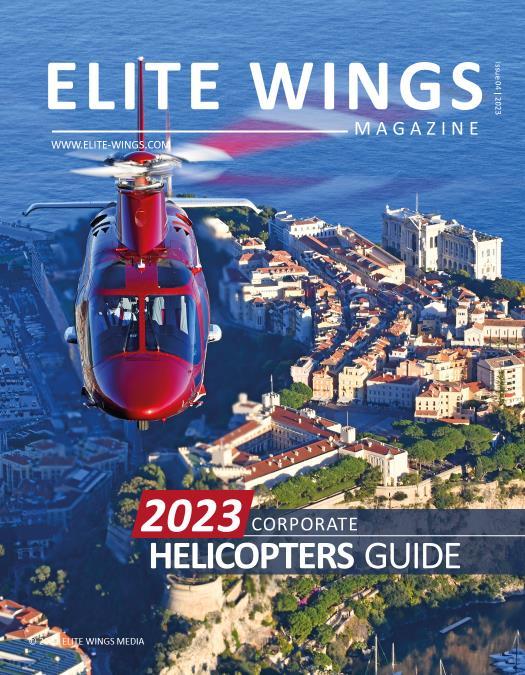
Any information of a technical nature contained in this document may contain inaccuracies and is subject to change and should never be relied upon for operational use
Copyright © 2022 All rights reserved. Reproduction in whole or in part without permission of ELITE WINGS MEDIA is strictly prohibited.
2 | ELITE WINGS MAGAZINE
WWW.ELITE - WINGS.COM


CONTENTS Summer 2023 2023 Corporate Helicopters Guide LIGHT SINGLE ENGINE 39 Bell 505 40 ACH125 41 Bell 407 GXi 42 ACH130 43 AW119Kx 44 AW09 LIGHT TWIN ENGINE 45 ACH135 46 AW109 Trekker 47 AW109 GrandNew 48 Bell 429 INTERMEDIATE 50 ACH145 51 AW169 MEDIUM 53 S-76D 54 ACH160 55 AW139 SUPER-MEDIUM 56 ACH175 57 AW189 58 AW609 Tiltrotor 59 Bell 525 Relentless HEAVY 61 H225 62 S-92 63 AW101 08 Robinson 50 years of simple, reliable and cost-effective helicopters 12 Agusta by Leonardo Leading the VIP/Corporate helicopter market with a large and modern product offering 18 Superyachts Helipad Design Ensuring superyacht helipad compatibility and safety operation 24 Airbus Corporate Helicopters The year of the ACH160 28 Pre-Owned Market Update Interview with Rotortrade on the state of the Corporate Helicopters Pre-Owned market 32 Bell Textron Business efficiency needs and adventure travel are boosting demand for Bell helicopters AW169 ©Leonardo





ELITE WINGS MAGAZINE | 5 08 12 18 24 32
COMMENT
The future of Air Mobility… is already here!
This year’s Elite Wings Magazine Special Corporate Helicopters edition is published during the week of the Monaco Yacht Show, the world’s foremost superyacht event. Yacht operations represent the highest end of corporate helicopter applications with the most luxurious models becoming a striking sight over Monaco’s bay during this event. It's also a good reminder that most of these great helicopters we are using today for corporate applications have been principally designed and perfected year after year to support the offshore Oil and gas industry carrying a DNA of enhanced safety and efficiency.
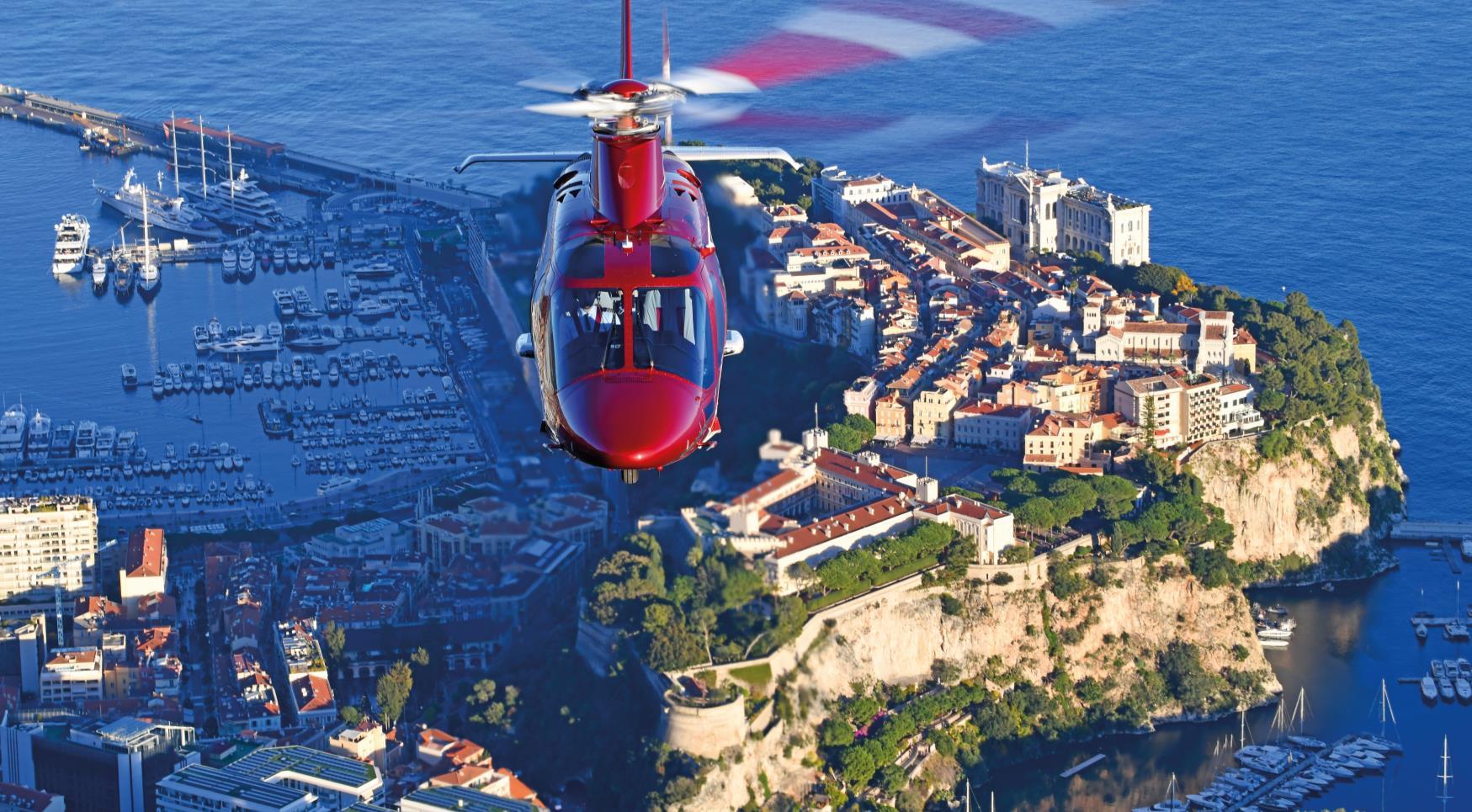
Although the Corporate Helicopters segment represents a fragment of the civil helicopters market with around 25% of the market share in 2022, it is a great business to be in for all turbinepowered helicopter players, that compete in offering the highest levels of innovation, comfort, and style to address this highly demanding market.
The civil helicopters market which was heavily hit by the pandemic is showing signs of fast recovery, driven by some of its traditional segments as the EMS (Emergency Medical Services), SAR (Search and Rescue), and Law Enforcement segments. The Oil and gas segment, which has been declining in the past years due to lower energy prices is finally showing signs of recovery, driven by higher prices due to the energy crisis. The corporate helicopters segment which was also highly affected by the pandemic is showing signs of recovery since the second half of 2022 with the resumption of passenger transport and the renewal of related fleets.
This momentum is driving civil helicopter manufacturers to dedicate more funding and engineering efforts to accelerate progress in sustainability and innovation to reduce the carbon footprint of current and future aircraft leveraging sustainable aviation fuel, hybridization, and electrification.
This guide is a good opportunity to discover new offerings such as the Airbus Helicopters all-composite H160/ ACH160 that entered service in 2022 and other soon-to-be-available models such as the Leonardo AW609 civil tiltrotor, that appears to be nearing the finish line as the FAA revealed this summer their new tiltrotor certification criteria as no standards existed for this new category of “powered-lift” aircraft class. Bell Textron is also in the final stages of certification of their full fly-by-wire super-medium Bell 525.
In this edition, we are also paying tribute to Frank Robinson, the founder of Robison Helicopter Company and the inventor of simple and reliable low-cost helicopters who passed away in November 2022.
Abdelmajid Jlioui, Editor-In-Chief
6 | ELITE WINGS MAGAZINE
AW109GrandNewoverMonaco©LEONARDO
Civil Helicopters Market In
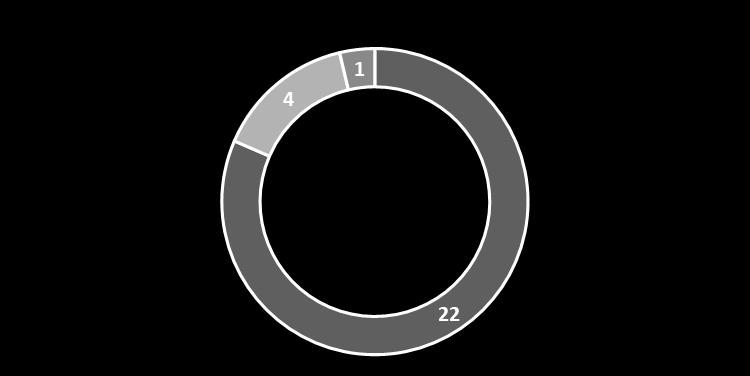



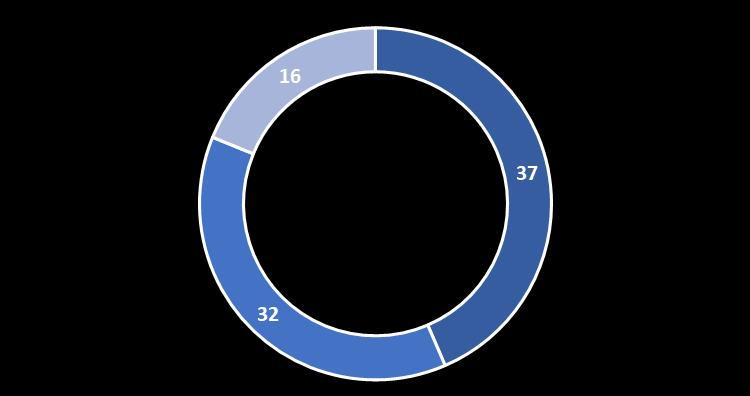
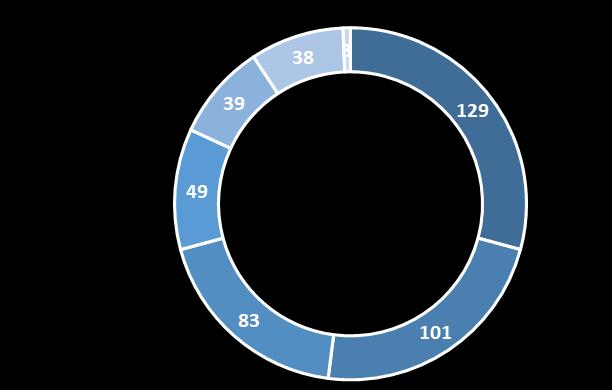
ELITE WINGS MAGAZINE | 7 316 258 207 134 92 30 28 Airbus Helicopters Robinson Helicopter Company Bell Helicopter Leonardo Helicopters Sikorsky Aircraft Corp. Hélicoptères Guimbal NHIndustries Kaman MD Helicopters Schweizer Aircraft Total 1,077
Numbers Deliveries by OEM* H125 R66 Bell 505 Bell 407 AW119 Kx H130 MD530 H135 Bell 429 AW109 H145 AW169 AW139 Bell 412 H160 AW189 H215 H175 H225 S-92 AW101 Light Single 442 Deliveries Light Twin 85 Intermediate 96 Medium 59 Super Medium 27 Heavy 27 1271 1068 862 1010 1077 0 200 400 600 800 1000 1200 1400 2018 2019 2020 2021 2022 2022 Total Yearly Deliveries* * Worldwide Rotorcraft Shipments, Piston & Turbine powered, CivilCommercial and Military-Government Combined, Source: GAMA. Deliveries by Model and Category
ROBINSON
Founded by Frank Robinson in 1973, Robinson Helicopter Company is celebrating this year its 50th anniversary.
 By Abdelmajid Jlioui
By Abdelmajid Jlioui
|
MAGAZINE
ELITE WINGS
The company is known for designing and manufacturing the most cost-effective helicopters on the market. Can you walk us through some key milestones in Robinson Helicopter's history?
Receiving FAA certification on the R22 in 1979, R44 in 1992 and the R66 in 2010 are all key milestones. When Robinson manufactured and delivered our 10,000th helicopter in 2011 that secured our legacy of one of the top helicopter manufacturers.
Robinson Helicopters are a very familiar silhouette in helicopter flight schools. Can you tell us how these platforms ensure future pilots have a good foundation for a successful flying career?
The R22 and R44 are both excellent flight training aircraft. Both helicopters have responsive handling, which allows students to develop a “feel” for flying that benefits them throughout their careers. Also, the lower operating costs makes it more affordable for students to fly more and to gain additional time and experience.
In April 2021, Robinson announced the delivery of the 13,000th helicopter, can you tell us more about some of the key market segments these helicopters are serving today?
The Robinson fleet operates around the world and in every climate imaginable. They are used extensively by private owners for personal transportation along with commercial operators for flight training, cattle mustering operations, tour, police, news gathering and agricultural work.
Since entry into service in 2010, the single-turbine powered R66 has proven a great success! How were you able to bring that level of reliability and costeffectiveness to the more complex turbine helicopter market?

Our design focus has always been to make helicopters as simple and reliable as possible and we carried that forward with the R66 Turbine. There are now over 1,200 R66’s operating around the world which have accumulated over 1.6 million flight hours, without a single engine failure. As the R66 gains more time and experience Robinson will continue talking to operators and monitoring the R66 fleet to find ways to improve the aircraft.
Robinson's is known for its robust worldwide network of dealers and service centers, outside of the USA, what markets do you see driving demand for piston and light helicopters?
Wherever our helicopters can be used to lower operational costs, such as providing transportation, cargo delivery, crop spraying, etc., demand will increase. In areas where wide-spread weather disruptions are occurring, flooding communities and making travel by roads difficult, the need for helicopters is only going to grow stronger.
ELITE WINGS MAGAZINE | 9
CLICK HERE TO DISCOVER MORE About Robinson’s History
Interview with Kurt Robinson President and Chairman Robinson Helicopter Company
In January 2008, President George W. Bush, accompanied by California Governor Arnold Schwarzenegger, visited Robinson Helicopter Company to promote free trade agreements pending before Congress. Robinson was selected as the venue for Bush’s statement based on the strength of its international sales. In 2007, exports accounted for over seventy percent of Robinson’s total sales.

ABOUT FRANK ROBINSON
Born in Carbonado, Washington in 1930. The youngest of four children, Frank grew up during the Depression. At the age of nine, Frank saw a picture in the Seattle Post Intelligencer of Igor Sikorsky hovering his VS300 Prototype helicopter. The idea that a machine could remain stationary in the air fascinated Frank, and set the course for his life’s work. As a young man, he worked his way through college focusing his education on helicopter design. In 1957, he earned a BSME degree from the University of Washington and later attended graduate school at the University of Wichita.
Robinson began his career in 1957 at the Cessna Aircraft Company working on the CH-1 Skyhook helicopter. After 3 1/2 years at Cessna, he spent one year at Umbaugh working on the certification of its gyroplane and then 4 1/2 years at McCulloch Motor Company doing design studies on inexpensive rotorcraft. Robinson went on to spend a year at Kaman Aircraft working on gyrodyne-type rotorcraft, followed by two years at Bell Helicopter where he earned a reputation as a tail rotor expert. In 1969, he moved to Hughes Helicopter Company to work on a variety of R&D projects, including a new tail rotor for the Hughes 500 helicopter and the quiet helicopter program. Unable to interest any of his employers in his concept for a small, low-cost helicopter, Robinson resigned from Hughes and in June of 1973 founded Robinson Helicopter Company (RHC) in his Palos Verdes home. The first R22 prototype was built in a tin hangar at the nearby Torrance Airport, and in August of 1975, Robinson flew the R22 on its first flight. In 1979, after 3 1/2 years of testing and technical analysis, the R22 received its FAA Type Certificate. The first R22 was delivered in late 1979 and soon became the world’s top selling civil helicopter.
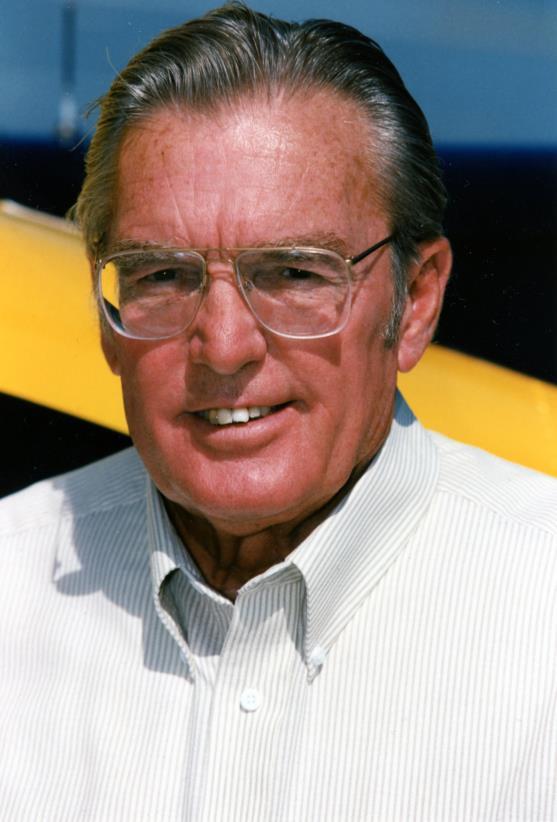
Frank retired at the age of 80.
The Company publicly announced his resignation as President and Chairman in August 2010.
Frank Robinson was the driving force behind the company’s success, with Robinson Helicopter Company becoming the world’s leading manufacturer of civilian helicopters since 1988.
Frank Robinson passed away in November 2022 at age 92.
10 | ELITE WINGS MAGAZINE
ELITE WINGS MAGAZINE

AGUSTA By LEONARDO

VIP & CORPORATE
HELICOPTERS OFFERING UPDATE
By Abdelmajid Jlioui
| ELITE WINGS MAGAZINE
With a 45% share over the last ten years, Leonardo is the world leader in the twin-engine VIP/corporate helicopter market including private, charter, and VVIP/Government transport services, thanks to the most modern and largest product range.
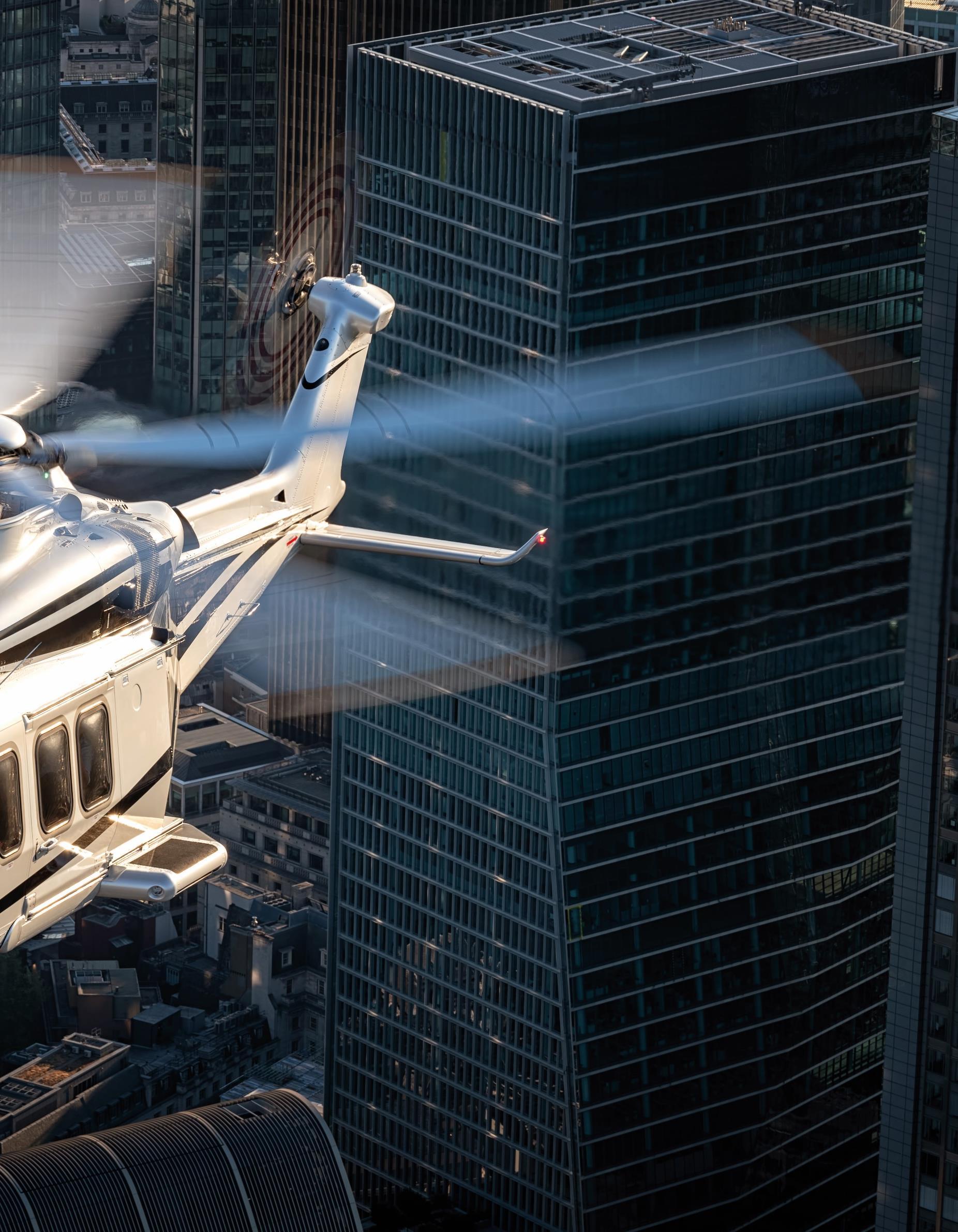
ELITE WINGS MAGAZINE | 13 AW139 ©Leonardo
In May this year, Leonardo was back at EBACE 2023 in Geneva with the strong Agusta brand dedicated to the VIP & Corporate markets. Can you give us an overview of the importance of the European market for Leonardo?

With a global fleet of more than 900 helicopters, carrying out a range of passenger missions, including private and corporate transport, charter, scheduled services and VIP/government transport, Leonardo is the global leader in this sector. The success of Leonardo’s offer to the VIP/corporate transport market continues to grow across geographies. Europe is the largest market for the commercial multi-engine VIP/Corporate helicopters and Leonardo is the leader with 44% of the fleet. Over the last three years, Leonardo’s helicopters deliveries have accelerated moving back to pre-pandemic levels and contributing to the company’s leading position of 55% share of the Europe’s multi-engine VIP/Corporate helicopters market over the last decade.
During EBACE 2023, Leonardo presented the latest updates on the AGUSTA FOR YOU service and maintenance package dedicated to private and corporate operators. Can you walk us through the key offerings of this program?
In the framework of the exclusives initiatives of Agusta, the AGUSTA FOR YOU service and maintenance package for private operators is conceived as integral part of the Leonardo VIP offer and it has been already selected by several customers around the world providing turnkey solution in terms of a complete coverage. Developed specifically to meet the needs of corporate rotorcraft operators, it is intended to increase aircraft availability and reduce inventory costs, while optimizing expenses by covering both scheduled and unscheduled maintenance of airframe, avionics components and other items.
The AGUSTA FOR YOU plan is available to all the Leonardo helicopters and it offers on demand possibilities of annual interiors refurbishment, coverage of entertainment system (parts and troubleshooting), coverage of engines unscheduled events (with performance guaranteed) and engine loan service. For those customers who decide to maintain their helicopter at Leonardo facilities, the AGUSTA FOR YOU service plan also provides premium services such as: facilitation in the rental of a “replacement” helicopter, in case of helicopter on maintenance; fuel arrangements; cabin cleaning service; direct
ramp access, when hangars are in a commercial airfield. Over the next two years, with the aim of progressively extend the possibility to access to the AGUSTA FOR YOU services through the entire Leonardo global service network, selected Leonardo helicopters part.145 maintenance centers will be renewed with Agusta-branded areas, bringing premium services closer to VIP clients in the main geographical areas such as Europe, Americas, South Africa and Australia.
NBAA-BACE 2022 was also marked by the first appearance of the AW609 tiltrotor in a VIP configuration, can you tell us more about the AW609 capabilities and how it may revolutionize the point-to-point private travel?
The AW609 will be the world’s first tiltrotor aircraft to obtain certification for civil use and it will be initially used in the passenger transportation sector, radically changing the concept of "conventional" flight. The new Agusta brand will reinforce its value proposition of the AW609 in the private transport segment.
The AW609 TiltRotor will redefine point-to-point transportation by combining the speed, range and altitude of a fixed-wing turboprop with the vertical take-off and landing versatility of a helicopter. Flying above bad weather thanks to its pressurised cabin, the AW609 will maximise personal time by providing the quickest method of travel from one location to another for distances of up to 500 nautical miles, transporting passengers in comfort and style.
Taking off from your own garden, from the roof of a parking lot, escaping the time constraints involved in travelling through airport hubs, such as traffic on the road to the airport, queuing to get through check-in and all the other essential security checks. For passenger transport (up to nine plus pilot and copilot), the AW609 can connect the centre of two cities such as Milan and London, in about two hours flight time, introducing a real revolution in point-to-point connections in a context of innovative inter-urban mobility. In only 40 seconds the AW609 can convert from helicopter to fixed-wing aircraft mode. Two totally different approaches to flight, as we all know: helicopters move vertically using rotors, while airplanes travel using wing lift and propulsion with high-power turboprops. For professionals in the field the tiltrotor offers the best of both worlds, while for everyone else it offers a completely new transportation concept for city to city travel or into remote areas.
14 | ELITE WINGS MAGAZINE
AW169 ©Leonardo
Interview with Leonardo
Latin America is another key market for VIP & Corporate helicopters, can you tell us more about Leonardo’s presence in this region?
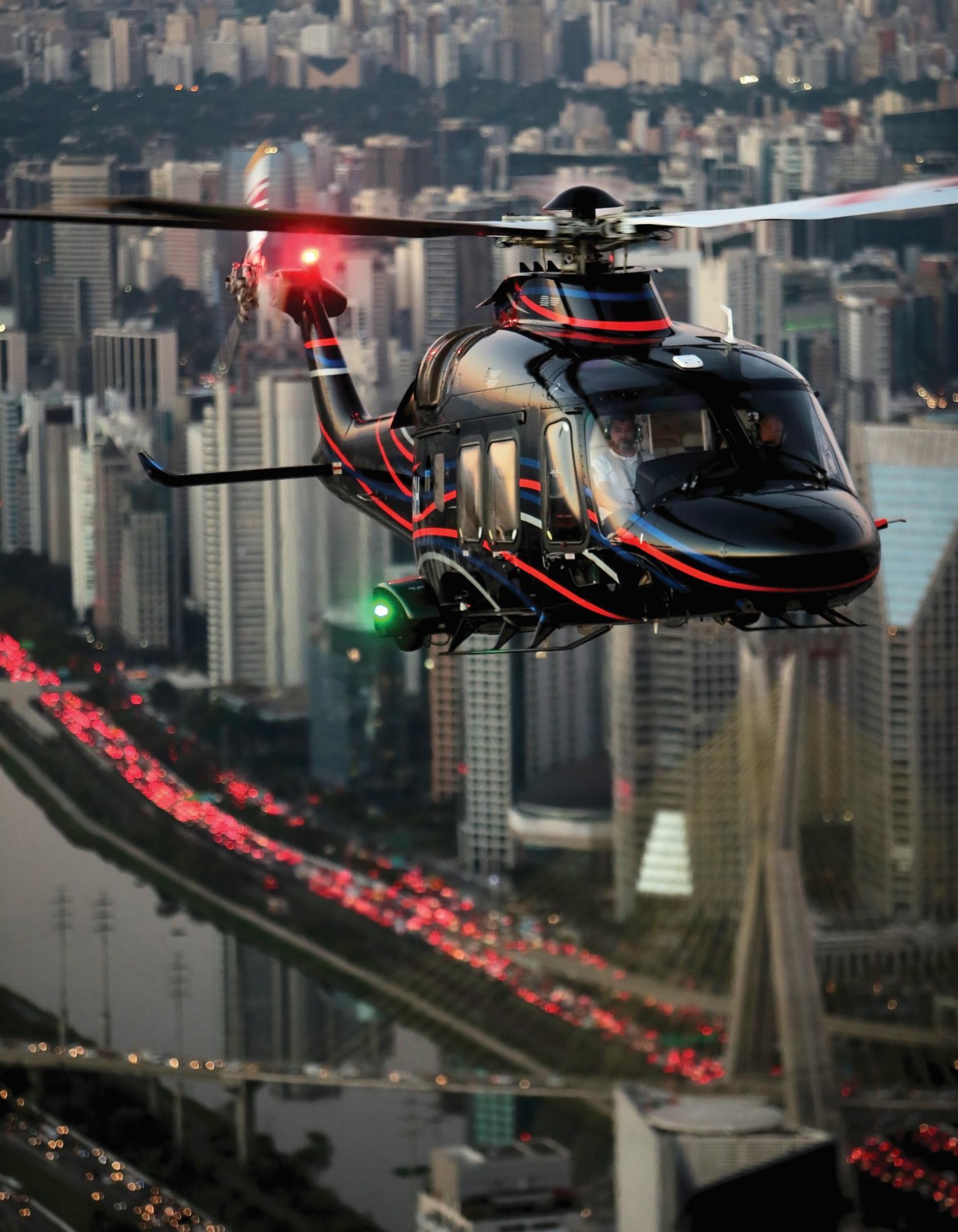
More than four-hundred Leonardo helicopters of various models used for a wide range of applications are in service throughout Latin America today. In the region, the VIP & Corporate segment represents for Leonardo a strategic market, with 50% of its fleet performing executive transport missions. The most popular types include the AW119 single engine, the AW109 light twin legacy, the AW139 intermediate twin and, more recently, the AW169 light intermediate. The AW189 has introduced new capabilities into the region supporting the energy industry.
At the end of 2021, to support the continued growth in the region, alongside the introduction of all new models for VIP, security, public service and offshore transportation, Leonardo opened a new Service and Logistics Centre. Headquartered in Itapevi, 30km far from São Paolo, the site can host up to 20 helicopters simultaneously and allows for a 50% capacity expansion when compared to the previous maintenance
capabilities in country, with the potential for further growth with a range of industry capabilities such as aircraft maintenance, training facilities, painting and completion. Leonardo has been providing helicopter maintenance services to its Customers in Brazil for two decades, and lately to enhance its services as an OEM (Original Equipment Manufacturer) and to meet the demanding expectation of the VIP market segment, has decided to invest in a new, modern, and functional facility, in order to provide even higher standards of services. The opening of the Centre has become a landmark, the start of a journey where VIP customers expectations can be exceeded, and the OEM has all the resources and infrastructure in country to provide service excellence with unmatched quality and safety. Leonardo has also in plan to restyle the Itapevi Centre VIP lounge for pilots with the Agusta brand. The project for the Itapevi Centre is further confirmation of Leonardo's commitment to strengthen the level of quality services, supporting helicopter operators in Latin America.
ELITE WINGS MAGAZINE | AW169 ©Leonardo
Can you provide us with an overview of the latest interior offerings for the Agusta line of helicopters?

Among the options and services dedicated to VIP/corporate helicopter operators under Agusta, the Interior Moods layouts are the latest Agusta proposals for interior layouts. Initially created for the AW169, AW139 and AW189 helicopter types, the Interior Moods are inspired by the names of iconic cities and are based on stylish specific colours, materials, seat configurations and on-board options. They are designed to allow customers to select and create their ideal and perfect environment, mirroring their own distinctive wants, while are also meeting their needs: from the sense of warmth, harmony and pureness of ‘Florence’, to the juxtaposition of opposites like tradition and innovation in ‘London’ and to the energy and passion shown by ‘New York’ and its cosmopolitan crossfertilization of habits and behaviours. Leonardo’s design team, which has been working for years with its customers around the world, has the specialist expertise to advise the clients on the perfect mix of features and high quality furnishings for his helicopter. Designing the exterior as well as the interiors to create a bespoke helicopter with a distinctive signature. The customers can enhance their flying experience by selecting from a choice of seat configurations and on-board options. Choosing colours, materials, feelings and with technology at their fingertips. Every detail will be brought to life with the finest Italian craftsmanship, creating an environment that expresses luxury, style, and refines.

16 | ELITE WINGS MAGAZINE
AW169 ©Leonardo
AW169 ©Leonardo

Superyachts Helipads Design
By Viswanath Tata
Onboard helipads are becoming a critical component of the latest generation of superyachts, with some vessels operating up to two heliports with large helicopters. It is important therefore to rely on industry experts to ensure preferred helicopter compatibility and compliance with the latest safety and regulatory requirements.

| ELITE WINGS MAGAZINE
Interview with Jonathan Turner Managing Director, Maritime Aviation
Maritime Aviation is known as the global leader in its field of heliport and helicopter operations on superyachts and cruise ships. We are the only company in the maritime industry that is an Aviation Inspection Body (AIB), heliport design consultant, specialist heliport equipment and lighting supplier and industryaccredited heliport crew training provider. This gives our clients great confidence in our service provision. With a portfolio of the most iconic superyachts in the world, our pedigree evolves from the excellence of Royal Navy aviation and helicopter operating companies, with our senior leadership team combining their many years of expertise in safely and efficiently operating helicopters from sea and shore locations around the world in sometimes very challenging weathers and conditions. It is this unequalled experience that has built our reputation and portfolio of aviation capable cruise ships and superyachts that explore all areas of the world including the polar regions.

ELITE WINGS MAGAZINE | 19
Amatasia © Tom Van Oossanen
Maritime Aviation is a global leader in shipboard aviation, can you walk us through some of the latest trends in superyacht helipads integration?
Maritime Aviation works with some of the most iconic superyachts, including many of the largest new builds. There are several trends regarding helicopter facilities onboard vessels throughout the superyacht industry.

In the largest size bracket, from around 100m -150m+ in length, there is an expectation that the vessel will have at least 1 shipboard heliport but more often 2, with at least one of 1 of these, if not both, being certified for commercial use. We are also seeing a growing trend to be able to operate 2 helicopters simultaneously, which requires not only greatly considered heliport design but also extremely robust operational procedures.
Most yachts in this larger bracket also have a helicopter refuelling system for Jet A-1, with differing storage tanks sizes dependent upon factors such as the helicopter type(s) to be operated, the tempo of intended flying operations and the location/remoteness of the operations, including whether clean Jet A-1 fuel will be readily available, ashore. Essentially, the more remotely a vessel will be operating with its helicopter(s), the more aviation fuel will usually be held onboard. This will need to be considered in itinerary planning and onboard fuel management provision.
Some yachts, particularly in the larger size range, also have onboard hangarage for 1 or 2 helicopters. There is a significant space requirement for this, however, which can be a challenge to incorporate, so it is less common in smaller yachts. There are several different design concepts for hangars onboard yachts, which can give different challenges. Some have the hangar on a different deck to the heliport and incorporate a helicopter lift to move the helicopter up and down within the vessel. Lifts can be extremely useful if they are designed appropriately but they can cause their own issues if they are not considered fully, using the ‘design helicopter’ for the vessel.
In the smaller range of aviation-capable vessels, from around 75m - 100m, there is a big trend for new builds and refits to have a shipboard heliport incorporated. Some owners will want a heliport to enhance the resale value of the vessel but, especially since the Covid-19 pandemic, we are seeing more and more owners wishing to spend time on their yachts and to access them directly via helicopter transfer from the airport where their jet lands.
Another trend which continues to gather popularity, is the ‘yacht support vessel’. Many yachts are getting larger so they can accommodate more guests, have bigger guest spaces and carry more (and bigger) toys. As the yachts get larger, however, there can be operational implications, such as physical restrictions for accessing certain marinas or berths. One way that this can be ameliorated is by having 2 vessels: the main yacht and a yacht support vessel. In this case, the support vessel will usually carry the helicopter, as well as submarines and the majority of tenders and toys. The support vessel may be smaller than the main yacht but have dedicated spaces not designed for guests. Yacht support vessels would usually have a certified shipboard heliport so that helicopters can be chartered around the world to support owner/guest requirements.
PhoenixII©BreedMedia | ELITE WINGS MAGAZINE
In the cruise industry, there is a growing trend for cruise ships to have an aviation capability. Cruise operators wish to offer a range of experiences not previously available to their clients, such as ‘flight-seeing’ tours and heli skiing. This is particularly true in the Polar regions, where there are ever increasing numbers of clientele wishing to experience these regions, including the unique wildlife. Such operations are often hightempo, involve high numbers of transfers and are high intensity. Clearly, when operating Commercial Air Transport (CAT) operations with fee-paying passengers from a cruise ship to a shore site, the highest standards of operations and procedures are required. This is true for both the helicopter operator and the vessel operator, which need to work seamlessly together to maximise efficiency and guest experience.
Some yachts and cruise ships have their own helicopter engineer onboard during high-tempo helicopter operations; some aircraft registries allow pilots to carry certain engineering approvals. The more capable the aviation facilities onboard and the longer that helicopters are intended to remain onboard during transits and other yacht operations, the greater the likelihood that a helicopter engineering will be carried onboard. In such cases aircraft tooling and spare helicopter components may be carried onboard the vessel; consideration needs to be made for the space requirements for these.
Maritime Aviation offers consultancy and project management for new build and refits vessels' shipboard heliport design, can you provide us an overview of some of the best practices to ensure safety and regulatory compliance?
There are many standards and regulations which may be involved with a yacht build, including flag, classification society and other standards, such as those required for a shipboard heliport to achieve commercial certification, such as the ICAO Doc. 9261, Heliport Manual. Some projects seek to use standards which are not considered appropriate for use on aviation-capable superyachts and cruise ships, and which could limit helicopter operations unnecessarily. Ultimately, when the yacht becomes operational, it should ideally meet the requirements and expectations set down by the owner at the project’s design stage. Understanding the rules, regulations and standards, including their applicability, is key to ensuring this occurs.
There are many potential pitfalls when planning to incorporate aviation into a superyacht or cruise ship. We regularly see significant issues and operational restrictions which have been built into a vessel, which could have been avoided if appropriate professional guidance had been sought, early in the project. Best practice is for owners, their representatives and project teams to engage appropriate maritime aviation specialists at an early stage in a project.
We often describe how engaging Maritime Aviation to consult early on in an aviation-capable yacht project, is like using an accountant to manage one’s financial affairs. The accountant understands all the current and forthcoming rules and regulations and uses their knowledge, expertise and experience to mitigate their clients’ exposure and acts to best protect their financial interests. Similarly, during a yacht project, Maritime Aviation will use its collective expertise to guide clients on
suitable helicopter types, shipboard heliport standards, heliport equipment requirements, onboard aviation safety management and crew training. The value added by employing a specialist in maritime aviation includes reducing costs and enhancing helicopter operations to ensure they are not only safe, but also efficient for the crew, whose time is often very limited. By comparison, most designers, naval architects or yacht management companies do not usually have any specific expertise in this complex area; they have their own skills and expertise in their own areas of responsibility.
Another important consideration is to ensure that all parties are aware of appropriate nomenclature. Terms and definitions are important because they have specific meanings and should not be misused. For instance, superyachts and cruise ships do not have ‘helidecks’, as helidecks are only used in support of oil and gas, as defined in ICAO Doc. 9261 Heliport Manual. Instead, a yacht or cruise ship would have a ‘shipboard heliport’, which would be either purpose-built or non-purpose-built shipboard heliport, depending on the design and other factors, again defined in ICAO Doc. 9261 Heliport Manual.
On a practical level, consideration should be given to only operating twin-engine helicopters with emergency flotation gear fitted, for use onboard shipboard heliports. Whilst some single-engine helicopters have fantastic safety records and have flown to the top of Mount Everest, for example, when operating to a vessel, with its confined landing areas, often in hot and heavy conditions at the critical stages of flight, a twinengine helicopter is recommended strongly; this is particularly true when flying commercial (fee-paying) passengers.
Maritime Aviation also offers Large Yacht Heliport Safety Training Courses for superyacht and cruise ship crew members. Can you give a summary of the operational requirements for ensuring onboard helipads and helicopter safety?
Irrespective of whether the yacht is operating a commercial or non-commercial heliport, safe and efficient operations are key. Sea-going vessels are unable to rely on additional, external support in the event of an aircraft incident or accident and should therefore ensure that crew members are trained and equipped to deal with any type of incident. Yachts with certified heliports must comply with regulatory standards such as the UK Maritime and Coastguard Agency (MCA) standard. Non-commercial heliports should make every effort to achieve similar standards as a matter of best practice.
The MCA Large Yacht Shipboard Heliport Training standard includes a wide variety of skills for different roles onboard a shipboard heliport, namely:
▪ Helicopter Landing Officer (HLO)
▪ Heliport Deck Assistant (HDA)
▪ Heliport Rescue Firefighter (HRF)
The HLO is the leader of the heliport and provides the link between the yacht’s bridge officers, the heliport crew and the helicopter pilot. The HLO will be dressed in full fire-resistant Personal Protective Equipment (PPE), including head, hearing and eye protection. They will have a portable Air Band VHF radio and will communicate with the Bridge and helicopter, manage the yacht’s resources and provide the leadership to ensure the helicopter operations are safe and efficient.
ELITE WINGS MAGAZINE | 21
The HDAs have 2 main roles: act as an HRF; act as a ‘Guest Guide’. The HRF role is a standby role where the crew member is dressed in full firefighting PPE, including Breathing Apparatus (BA) ‘off air’ to act in the event of an accident or serious incident on the heliport. The ‘Guest Guide’ is a support role where the crew member is dressed in similar PPE to the HLO and will perform tasks such as attach/remove helicopter lashings, guide the guests across the heliport and, if trained, refuel the helicopter.
There are 4 courses in the MCA suite which train for all these roles, including helicopter refuelling. The training covers both theory and practical elements of both Standard Operating Procedures (SOPs) and Emergency Operating Procedures (EOPs). Maritime Aviation is unique in providing live fire helicopter rescue and firefighting using our bespoke Helicopter Rescue & Firefighting Training Units (HRFTUs), one of which we move around Europe to where our clients are based, in Germany, the Netherlands and France; we have others at our UK base.
Onboard helipads may require additional scrutiny by yacht Insurance companies. What are the main red flags to watch for?
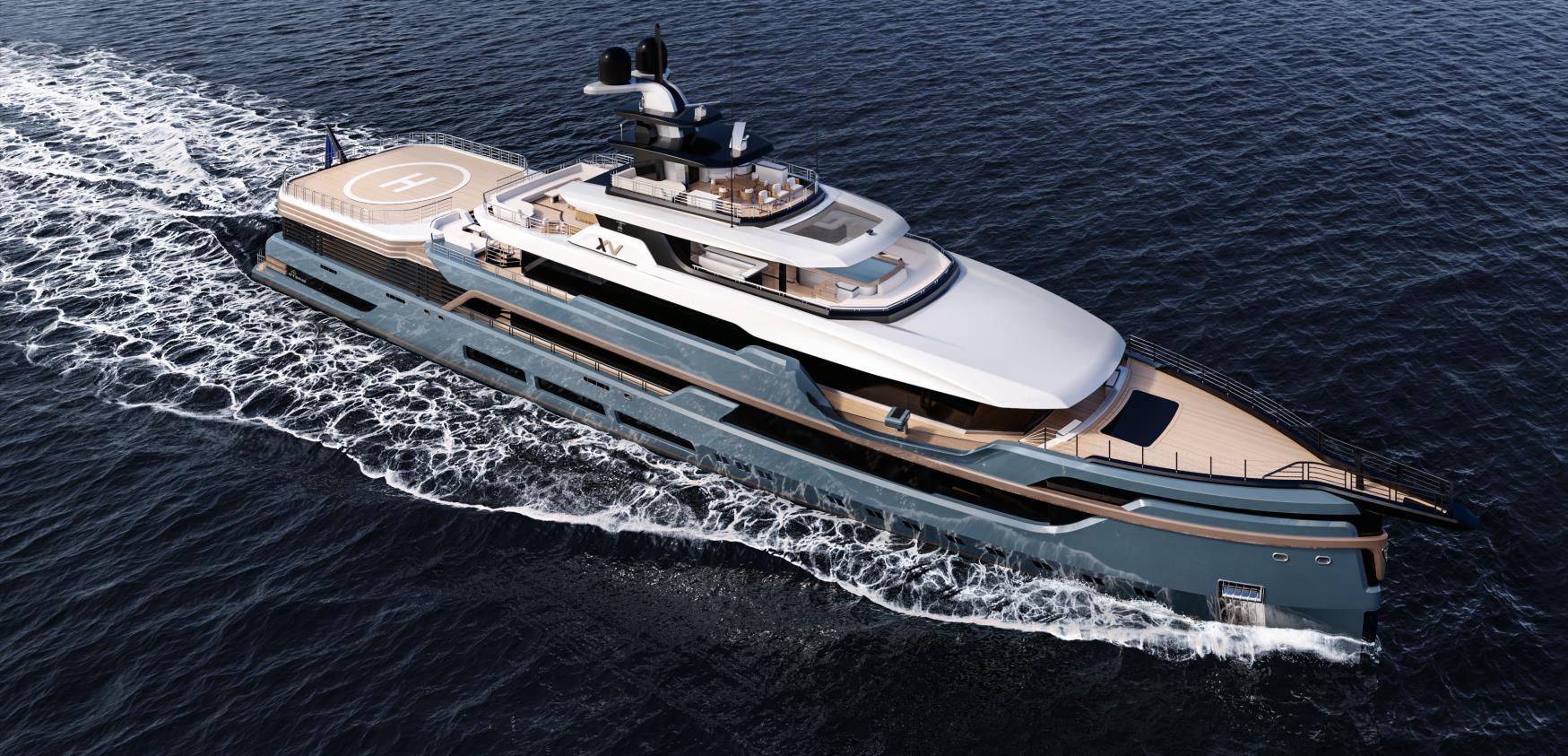
Insurance is key for aviation-capable yachts; there is the yacht’s hull insurance and the helicopter’s hull insurance. The sphere of maritime aviation is where the maritime industry overlaps with the aviation industry. Both industries have their own welldefined sets of regulations but understanding how they work together, is key. Understanding when responsibility transfers from the landing helicopter, to the yacht, for example, is vital for insurance purposes.
Commercial yachts with certified shipboard heliports will meet published standards (e.g. dimensions, obstacle clearances, lighting etc.) and will be surveyed regularly to ensure they comply with the required standards. They are required to have a safety management process, including regular safety audits, heliport equipment audits, bespoke Shipboard Heliport Operations Manual (SHOM), industry-accredited crew training
and procedures to enable the crew to deal with all types of incidents. This is a relatively straightforward position for insurers as it should be demonstrative that the highest standards have been set and maintained.
Yachts with non-certified heliports, however, are usually all very different and will not usually be able to comply with commercial standards for a variety of reasons, such as size/dimensions and obstacle environment. These areas of noncompliance usually introduce greater hazards and risk, which would usually be factored into the yacht’s insurance. Each vessel will have to be assessed on its own merits but for this reason, it is recommended that even yachts with non-certified heliports comply with, or operate as close as possible to compliance, with certified standards. For instance, every yacht should have a bespoke Shipboard Heliport Operations Manual (SHOM), all crew should be trained to known standards and a full suite of suitable, specialist equipped should be provided to deal with SOPs and all types of potential incidents (EOPs), onboard. This would mean having an iterative safety management process, managed by a competent entity, such as Maritime Aviation.
An interesting scenario is where a yacht wants to charter a commercial aircraft to operate to a non-certified heliport, as the charter operator will usually have specific requirements and standards for where it can operate and land. Also, the vessel may be operating in cold environments, such as the Poles, in ‘hostile environments’ with limited Search & Rescue (SAR) options and flying over very cold water. Different aircraft registries have different approaches to such scenarios but our message would always be for vessels and operators to operate to the highest standards attainable. Ultimately, if there is an incident or accident, the subsequent inquiry would look into all elements of the flying operation, including training certification, heliport standards, manuals, records, etc., so the closer a yacht can be to complying with regulations and industry best practice, the better.
22 | ELITE WINGS MAGAZINE
Xventure © Winch Design
Winch Design is an award-winning design studio, established in 1986 as a specialist exterior and interior yacht designer, by Andrew Winch and his wife Jane.

With the focus on extremely high-end bespoke, dynamic design for a worldwide client base, Winch Design is now recognised as one of the leading International design and architectural studios, having added Aviation, Architecture and Interiors teams to the core yacht business.
Over the years, Winch Design has established itself as the goto design studio for individuals who expect not only the highest levels of design excellence but also a totally bespoke, integrated approach, individually tailored to their lifestyle, whether it is a home, yacht, private jet, helicopter or train.

Xventure © Winch Design ELITE WINGS MAGAZINE | 23
AIRBUS CORPORATE HELICOPTERS The year of the ACH160!
 By Abdelmajid Jlioui
By Abdelmajid Jlioui
Since its introduction in 2017 by Airbus Helicopters, Airbus Corporate Helicopter (ACH) has been bringing an exclusive endto-end ownership experience to the private and business aviation customer segment.
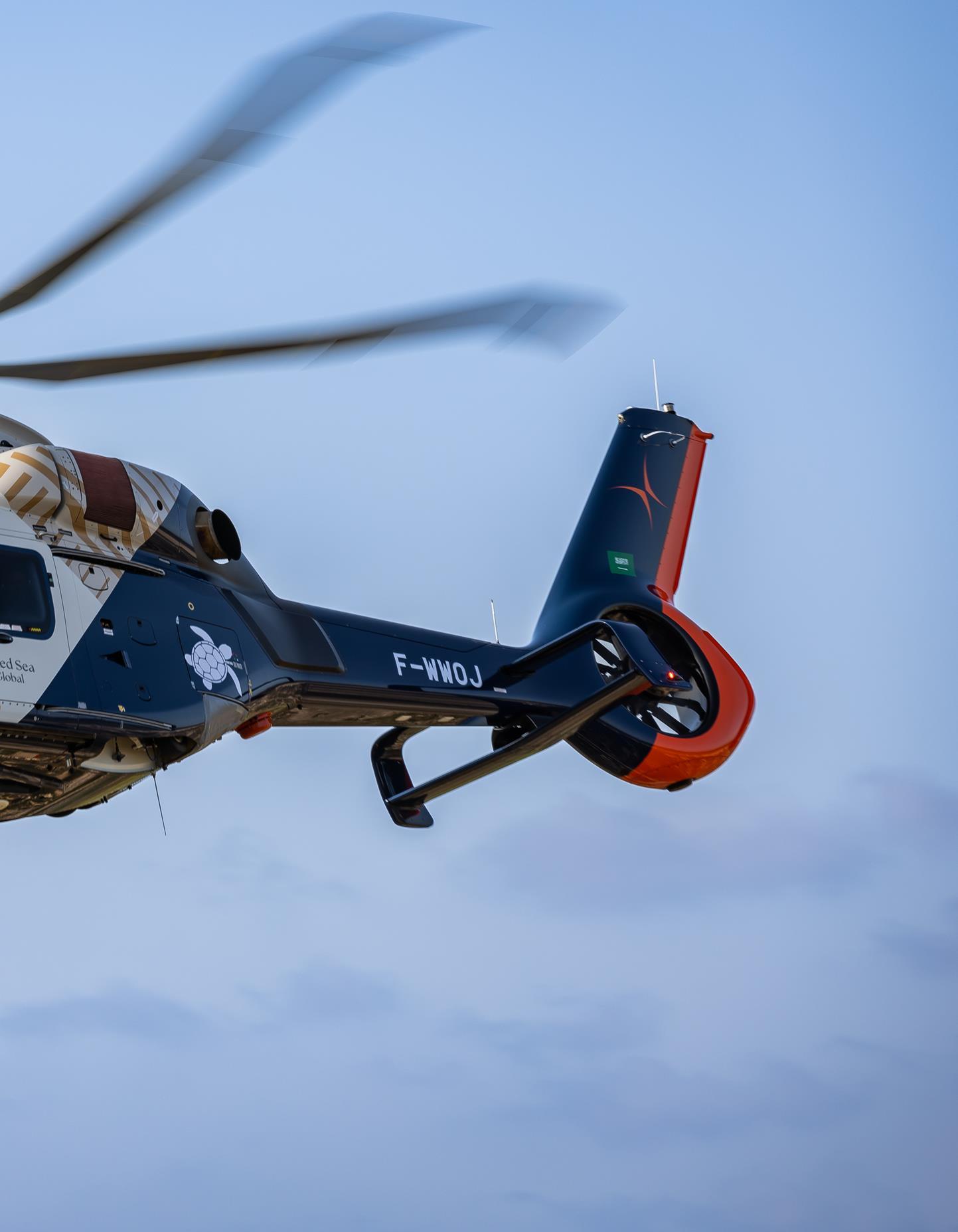
ELITE WINGS MAGAZINE | 25 ACH160 ©Airbus
Airbus Helicopter is leading the civilian rotorcraft market with 344 Deliveries in 2022, can you give us an overview of the global helicopter market demand in 2022 and how the Private and Business Aviation (PBA) segment of this market is performing?
When you look at the overall helicopter market today you can see that it is still quite challenging due to the well-known uncertainties and instability in some parts of the world. But Airbus Helicopters still had a very good year in 2022 in terms of new orders overall and in the PBA segment, it was a record year for us. ACH secured 114 new helicopter sales which is a 44% share of a growing market. So it is a great business to be in and we have new products like the ACH160, and upgrades of our current models like the five-blade ACH145, that give us a lot of confidence that we can go on meeting customer expectations in the future.
Can you give us an overview of ACH's portfolio of products and services exclusive to this segment?
ACH offers a wide array of products from the intermediate singleengine ACH125 and ACH130 all the way up to the ACH225. In terms of cabin interiors and equipment, there is also a large choice to respond to the variety of needs and profiles of our customers: corporate - business operations, private use, and governmental transport – in the form of ACH Line, ACH Editions and ACH Exclusive. Our single-engine offering often appeals to pilot owners or newcomers as well as clients operating on smaller platforms and willing to upgrade to high-end singles with more capabilities. Then you have the twin-engined ACH135 and especially the ACH145 which are extremely popular and particularly valued for urban areas, remote exploration and motoryacht operations. The ACH145 has a very modular cabin which can take up to nine passengers and is easily reconfigurable
for different missions while being remarkably compact and easy to operate in any environment.
What is very exciting is that in the medium class, taking up to 10 passengers, the ACH160 has now been certified in several countries among which, the USA, Brazil as well as Europe and is in service with the earliest customers. It is a superb helicopter that is accepted as the most technologically advanced civil helicopter on the market and sets new standards in passenger comfort, style and safety. The ACH175 is set for those aspiring to the highest levels of range, comfort, and refinement. It serves as the perfect extension of a corporate jet. It’s the quietest, fastest and longest-range helicopter in its category and can take anything up to 12 passengers. And finally, there is the ACH225 which responds to the Governmental transport requirements with the possibility to have some military equipment fitted in it.
At EBACE last year, ACH announced the extension of the ACH130 Aston Martin Edition production after the selling out of the initial production run. What makes this single-engine helicopter so popular?
We’ve really exceeded our own expectations with the success of this special edition of the ACH130. The idea was to make something that reflected the aspirations of the type of individual who would buy Aston Martin’s luxury sports cars. It needed to feature Aston Martin’s unique range of interior and exterior designs but on a sporty and agile helicopter which would delight owners and pilots who appreciate the pleasures of possessing and driving this type of car. I think clearly, we achieved that and this year we have added new design elements by incorporating Aston Martin’s updated colour palette so we have every belief that we will attract more customers for what is an incredibly distinctive helicopter.

26 | ELITE WINGS MAGAZINE
ACH130 ©Airbus
Frederic Lemos, Head of Airbus Corporate Helicopters answers EWM’s questions
2022 saw the first ACH160 worldwide delivery in Brazil, paving the way for a strong return of ACH to the popular medium size helicopters segment that was once dominated by the AS365 “Dolphin”. How do you see the ACH160 changing the game in this segment?
The ACH160 is going to transform the medium class in the PBA market. It brings an extraordinary combination of advanced cockpit technology, outstanding passenger comfort and high performance in one helicopter. For the pilot it means significantly reduced workload which results in safer operations in all phases of flight. And for passengers the experience sets new standards. The ride is exceptionally smooth and the noise levels remarkably low. Each passenger has around 20% greater personal space than in previous generation medium twins and the cabin is beautifully light and airy with windows that are about one-third bigger than its competitors. The air conditioning and temperature control are also extremely efficient and contribute a great deal to the overall sensation of comfort.
We once again offer the ACH Line interior which is clean and elegant and very well received by passengers in all our range, but we also propose the Exclusive interior which maximises the level of comfort with a timeless and sophisticated feel. So we’re very confident that customers for the ACH160 are get enormous enjoyment and satisfaction out of flying in it.
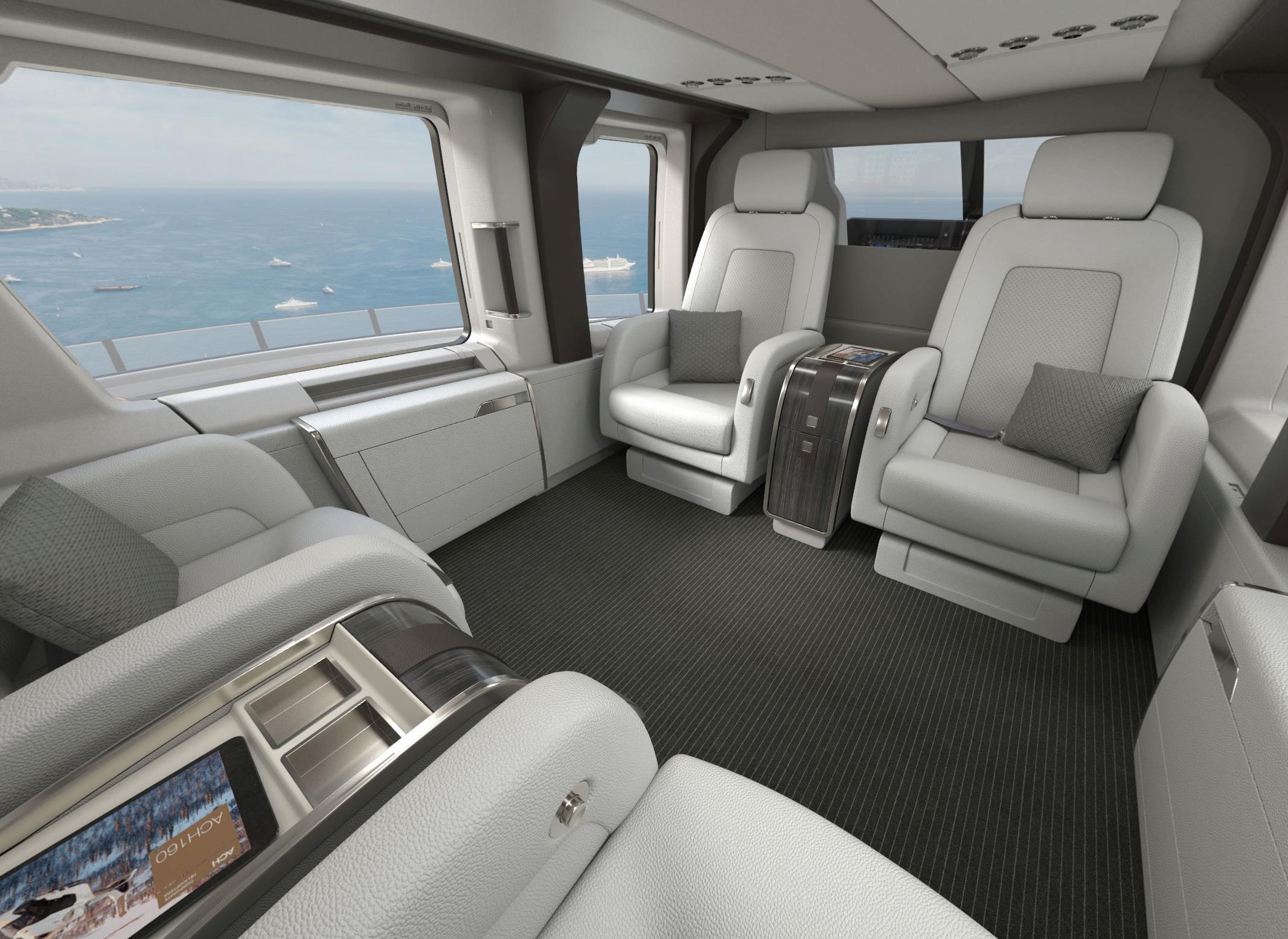
Airbus Helicopters unveiled last year a new support and services structure. ACH customers can benefit from the newly announced HCare First package. Can you give us an overview of this offering and the popularity of the HCare program with private and business aviation customers?
We now call the support and services package ACHCare. It’s an extended programme specifically created to support customers who need a worldwide first-class service and it runs through an exclusive five year or 1,000FH contract. It offers premium coverage and peace of mind at a fixed monthly payment while keeping the aircraft at its best. The service can also be bespoke to integrate even wider coverage.
As long as a customer owns the aircraft they receive a comprehensive service which ensures the very highest availability of the helicopter and also helps preserve the aircraft’s resale value because of the dedicated care and support provided by ACH through its large network.
We’re represented through 30 customer centres and some 100 MRO approved service centres, supported by ten logistics hubs. So we’re ready to ensure that maintenance and upgrade work is completed efficiently, and downtime is minimised by very rapidly addressing Aircraft On Ground (AOG) situations.
ELITE WINGS MAGAZINE |
ACH160 ©Airbus
PRE-OWNED MARKET UPDATE
By Viswanath Tata
Interview with Aurélien Blanc
EVP Sales & Board Member
Rotortrade
Can you provide us with a quick overview of the pre-owned market for corporate and private helicopters in 2022?

In 2022, pre-owned sales for corporate helicopters remained robust, although not quite matching the levels of 2021. Nonetheless, it's essential to recognize that the global geopolitical situation, fears of economic recession and overall inflationary pressures contributed to reduced helicopter trading activity across all segments in 2022 compared to the previous year. Interestingly, brand-new sales bucked this trend, experiencing a slight uptick in numbers as production rates started to increase slowly and new orders kept coming in.
As mentioned in last year’s interview, in the latter half of 2021, we observed a decline in the supply of helicopters available for sale. This trend continued into the first half of 2022, reaching its nadir around the summer season before stabilizing for the remainder of the year.
28 | ELITE WINGS MAGAZINE
ELITE WINGS MAGAZINE
What are the major trends in the first half of 2023?
2023 is on track to match or even exceed the pre-owned sales figures of 2022. By the end of August, acquisitions reached approximately 70% of the total sales recorded last year. Notably, pre-owned sales in the corporate helicopter sector have continued to rise beyond the same period last year during the first half of 2023.
On the sourcing side, after nearly a year of stable supply, we've recently observed a slight down trend. Indeed, we've noticed a gradual uptick in the number of helicopters listed for sale over the past 2 to 3 months which should help further stabilize prices.
However, we don't anticipate asking prices to decrease in the near future. The demand for helicopters remains strong, and high inflation continues to be felt throughout the industry, affecting manufacturers and spare parts dealers alike. On the brand-new helicopter side, deliveries continue to be held back by important logistical problems and perhaps some strategic management caution to ramp up production much faster. Long lead times affecting new helicopters continue to bolster pre-owned sales.
The demand for corporate and private helicopters has been traditionally driven by the US and Brazil markets, do you see these markets still as strong?
In comparison to 2021, the only regions that experienced growth in 2022 were Latin America and MEA (Middle East and Africa). As is customary, Latin America's growth was primarily fueled by Brazil's activity in the corporate segment, accounting for more than 72% of all pre-owned acquisitions in the region. Despite the reduced numbers in North America, it remains the leading region in terms of activity, driven primarily by the United States.
What are some of the emerging markets you see driving future demand?
Reviewing the first two quarters of 2023, what stands out most is the robust market activity in North America. It has already nearly matched the numbers of 2022, with four months still remaining. The United States, in particular, is only five sales short of reaching last year's total pre-owned acquisitions. Even Europe has begun 2023 on a strong note, achieving 78% of the previous year's acquisitions with just 66% of the year elapsed.
In addition, it is evident that 2023 is emerging as the year when the energy sector takes back center stage. There has been a surge in investments in alternative energy sources such as solar and wind farms, coupled with a renewed interest in offshore operations.
The substantial increase in oil prices experienced in 2022 prompted the industry to rapidly prepare for heightened demand, and this momentum has carried forward into 2023, marking a significant turnaround for the sector.
The price levels witnessed in 2023 not only validate the current optimism but also serve as a catalyst for the ongoing expansion of exploration efforts.
Aurélien Blanc, EVP Sales & Board Member Rotortrade

About Rotortrade
Rotortrade, the global leading helicopter distributor, specialises in the acquisition and sale of pre-owned helicopters. Rotortrade has the largest selection of wholly owned helicopters available today. With a well-established presence in the industry, backed by strong OEM support and a robust global network of partners, Rotortrade is playing a key role in transforming the pre-owned helicopter market.
Rotortrade excels in handling complex cross border projects with precision. Rotortrade demonstrates exceptional skill selling and sourcing helicopters globally either directly or on behalf of its clients, enhancing its reputation as a trusted and versatile partner. The company is also renowned for its management of brand-new helicopter programs, its experience in the meticulous repossession of assets and for delivering innovative trade-in solutions.
As the sole distributor of Leonardo pre-owned helicopters, an authorised Airbus reseller, and the only helicopter dealership that provides Nose-to-tail Certified Pre-Owned Helicopters, Rotortrade offers #HelicoptersYouCanTrust.
For more information, please visit: http://www.rotortrade.com/
ELITE WINGS MAGAZINE | 29
ANZ . CANADA . CEE . CHINA . FRANCE . KSA . MALAYSIA . MEXICO . SINGAPORE . SPAIN . UK . USA
ELITE WINGS MAGAZINE
NEW VS PRE-OWNED MARKET
This year marked a significant milestone for us with the release of our inaugural annual market summary, the RT365 Helicopter Market Report (available at https://www.rotortrade.com/2023-helicopter-marketreport/). In addition to a comprehensive analysis of market dynamics and trends, this report introduced a novel feature: insights from industry experts. We conducted a survey to gauge the industry's sentiments on various aspects, including preferences between brand-new and pre-owned helicopters, as well as key purchase drivers such as budget considerations.

The feedback we received from industry professionals is a testament to the growing trust in pre-owned helicopters. In fact, satisfaction rates from buyers of pre-owned helicopters were reported to be even higher than those for brand-new ones. However, a common request emerged from these insights – a call for enhanced transparency. Industry stakeholders stressed the importance of clear and detailed information regarding the assets being advertised and the accompanying documentation.
Before making a purchase, customers should seek out reputable dealers and brokers who possess the expertise and experience necessary to facilitate a smooth transaction.
Buyers should expect these professionals to take full responsibility for the process, and in the bestcase scenario, act as principal taking on direct & contractual legal liability. From a cost perspective, customers should inquire about the range of services offered by dealers and brokers, including assistance with escrow services, shipment arrangements, import procedures, retrofit options, and the evaluation of subcontractors.
30 | ELITE WINGS MAGAZINE






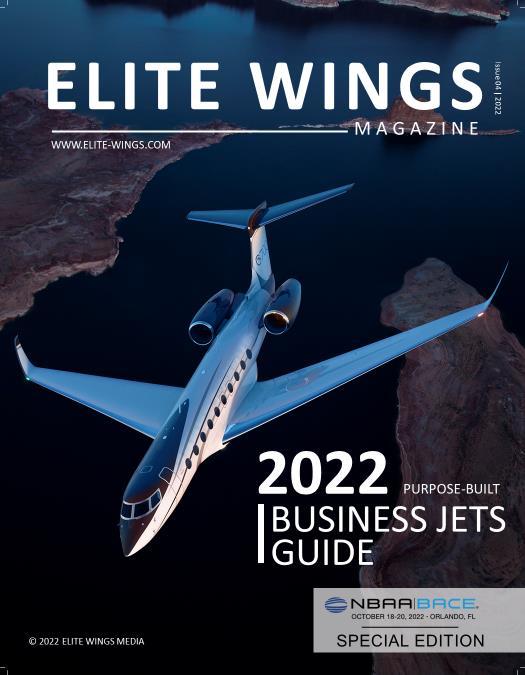



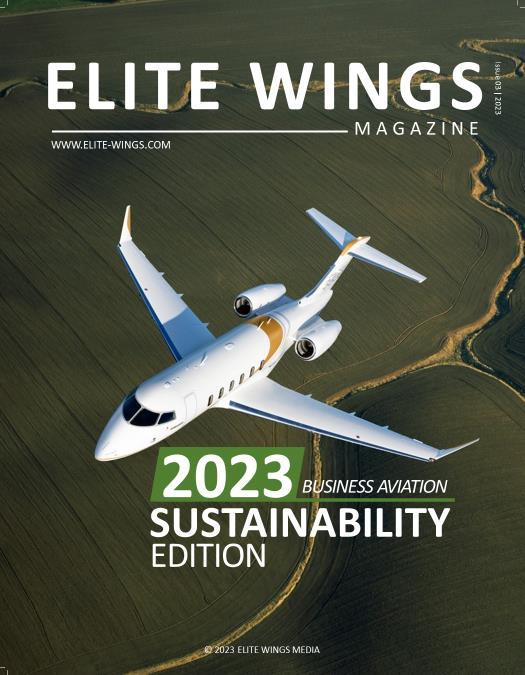
31 | ELITE WINGS MAGAZINE WWW.ELITE-WINGS.COM ELITE WINGS The Information you need….When you need it! The Trusted Source for Timely and Structured Business Aviation Intelligence Scan the QR code to view digital copies

| ELITE WINGS MAGAZINE
Bell Textron
with commercial helicopter deliveries reaching 179 units in 2022, demand across the commercial segment continues to be strong for Bell, especially in the VIP and Corporate markets
 By Abdelmajid Jlioui
By Abdelmajid Jlioui
ELITE WINGS MAGAZINE | 33
Bell 407GXI / Bell 429 ©Bell
2022 was a great year for Bell, with commercial helicopter deliveries reaching 179 units. What are the main drivers for such strong demand in the commercial segment?

Demand across the commercial industry continues to be strong for Bell, especially in the VIP and Corporate markets. Bell also saw strong demand across our Helicopter Emergency Medical Services (HEMS), Public Safety, and Utility that help complete the commercial portfolio options for Bell. Driving this demand is a return to normalcy post pandemic and a renewed interest in private travel, business efficiencies, and adventure travel. Customers have been seeking the ability to skip crowded terminals or FBOs and fly direct to their meetings or homes giving them complete privacy as well as time back in their busy weeks and weekends. The rise of adventure seekers and those looking for unique experiences have found that helicopters are able to reach areas and bring them and their families to new heights.
How was the corporate & VIP missions market performing in 2022, and how do you see demand progressing in the coming years?
The VIP and Corporate market continues to be a strong market for Bell across our 505, 407GXi, and 429 models. With the introduction of the new Designer Series interior for the Bell 429, we saw renewed interest in the platform from customers looking for the latest in comfort and aesthetics from a cabin interior. On the heels of the pandemic, customers have found helicopters to be the most private way to travel with the ability to skip airport terminals or FBOs altogether. In addition, the time efficiency helicopters bring to both private and corporate travel brings new levels of productivity to helicopter owners. We believe demand will continue to be strong in the VIP and
Corporate markets as owners continue to find benefit in time and comfort from helicopter travel.
The short light single-engine Bell 505 reached the 100,000 flight hours milestone in 2022. How is this compact platform performing in the Corporate & VIP missions?
The Bell 505 has become a fan favorite amongst the corporate and VIP market. From its high level of safety technology like integrated avionics and 3-axis autopilot to the comfortable spacious cabin, the Bell 505 provides a great set of features for this market. Especially in regions where owners are also operating the aircraft themselves, the 505 provides an almost SUV like utility where it is operated for work during the week and for fun on the weekends. The 505 can be upfitted with various creature comfort items like leather seating, ruggedized flooring, charging ports, and air conditioning that help fulfill the customers needs for their mission.
Bell announced several orders for The Bell 407GXi. What makes this helicopter so popular for corporate and VIP transportation?
The Bell 407GXi is considered the sports car of the sky. Both smooth and fast, the 407GXi is a pilot favorite for its tight controls, smooth rotor system, and integrated avionics system. Comfortable club seating in the 407s rear cabin is ideal for corporate transport where traditional all forward-facing seats might feel like a helicopter tour instead. The recent addition of IFR certification in multiple countries adds to the utility of the airframe where now owners are able to use their aircraft in Instrument Meteorologic Conditions (IMC) further enhancing utilization rates. Last, but not least, the 407 is incredibly reliable with up times in the high 90%s meaning the asset is always available when you need it.
34 | ELITE WINGS MAGAZINE
Bell 407GXI ©Bell
Matt Jayne, Senior Manager Commercial Product Marketing, Bell answers EWM’s questions
The twin-engine Bell 429 also marked an important milestone in 2022, as it surpassed 500,000 global flight hours. Can you provide us an update on the corporate market demand for this helicopter especially following the introduction of the new enhanced Designer Series interior?

The Bell 429 is seeing demand from both new and current 429 customers, especially with the completely revamped Designer Series interior. The 429s speed and smooth flight characteristics, both important characteristics to the VIP & Corporate market, make it a leader in the light twin engine segment. The Bell 429 has the ability to customize the cabin to customer needs whether 4, 5, or 6 seats or a variety of leathers, colors, and console options and ample baggage space. The Designer Series takes this to the next level with high end leathers and plated metals matching the quality and expectations of customers accustomed to the finishing of high end automotive, fixed wing, or marine products. The refreshed look is also attracting customers who have earlier serial number 429s looking for a refresh of their asset where they can also take advantage of the continuous improvement Bell engineering has worked into the reliability of the machine.
Last year saw Bell introducing a new Executive Customer Advantage Plan option, designed for corporate/VIP customers. Can you provide us with more details on this offering?
Bell’s Customer Advantage Plans (CAP) keep maintenance costs predictable and customer aircraft at the ready with access to our exclusive rotable pool of inventory, saving customers from downtime. The customer can select either the 100 Executive Flight Hour plan or 200 Executive Flight Hour plan for one year of unscheduled maintenance coverage. Whether they need routine care or have an unplanned maintenance event, CAP is designed to give customers peace of mind.
The clean-sheet super-medium Bell 525 is getting close to its type certification, can you provide an update on the program and how you see this platform performing in the corporate & VIP missions?
Bell 525 team is currently engaged with the FAA on Type Inspection Authorization (TIA) flight testing and is submitting certification artifacts to the FAA in parallel. The Bell 525 offers industry-leading minimal vibrations and best-in-class cabin volume, with optional kits for WiFi for entertainment streaming or email access. The aircraft’s features offer a luxurious travel experience for business or leisure.
35
ELITE WINGS MAGAZINE |
Bell 429 ©Bell
MANUFACTURERS ARE INVESTING FOR A CLEANER, GREENER FUTURE
Civil helicopter manufacturers are dedicating more fundings and engineering efforts to accelerate progress in sustainability and innovation to reduce the carbon footprint of current and future aircraft leveraging sustainable aviation fuel, hybridization, and electrification.

In November 2022, Airbus unveiled its DisruptiveLab, a new flying laboratory designed to test technologies destined to improve aircraft performance and to reduce helicopters’ CO2 emissions by as much as 50 percent
Next Generation Civil Tiltrotor (NGCTR) - Leonardo is developing a new model of a more efficient, eco-friendly next generation civil tiltrotor within the European Clean Sky 2 Programme, with the objective of reducing CO2 emissions up to 50% and noise emissions by 30% in the take-off phase and up to 75% in the flyover

36 | ELITE WINGS MAGAZINE
2023CORPORATE HELICOPTERS
 By Abdelmajid Jlioui
By Abdelmajid Jlioui
37 | ELITE WINGS MAGAZINE LIGHT SINGLE ENGINE 3,500 lbs < MTOW < 7,000 lbs & Single Turboshaft Engine 35 BELL | BELL 505 36 AIRBUS | ACH125 37 BELL | BELL 407 GXI 38 AIRBUS| ACH130 39 LEONARDO | AW119Kx 40 LEONARDO | AW09 LIGHT TWIN ENGINE 3,500 lbs < MTOW < 7,000 lbs & Dual Turboshaft Engines 41 AIRBUS | ACH135 42 LEONARDO | AW109 Trekker 43 LEONARDO | AW109 GrandNew 44 BELL | BELL 429
INTERMEDIATE 7,000 lbs < MTOW < 10,000 lbs 46 AIRBUS | ACH145 47 LEONARDO | AW169 MEDIUM 10,000 lbs < MTOW < 15,000 lbs 49 SIKORSKY | S-76D 50 AIRBUS | ACH160 51 LEONARDO | AW139 SUPER MEDIUM 15,000 lbs < MTOW < 20,000 lbs 52 AIRBUS | ACH175 53 LEONARDO | AW189 54 LEONARDO | AW609 TILTROTOR 55 BELL | BELL 525 HEAVY 20,000 lbs < MTOW 57 AIRBUS | H225 58 SIKORSKY | S-92 59 LEONARDO | AW101
with a take-off weight of over 3,500 lbs.
In-Production Turbine-powered helicopters
LIGHT
3,500 lbs < MTOW < 7,000 lbs
With their large mission versatility and efficiency, Light helicopters are the most popular helicopters in the civil market. The Light category is divided into two sub-categories: single and Twin-engine.

The primary differences between single and twin-engine helicopters lie in their power and speed capabilities. Twin-engine helicopters provide greater overall power and speed when compared to their single-engine counterparts. The engine redundancy is especially valuable when flying over water, densely populated areas, or inhospitable terrains.

| ELITE WINGS MAGAZINE ACH130 Aston Martin Edition ©Airbus AW109 GrandNew ©Leonardo
LIGHT SINGLE ENGINE
BELL| BELL 505
The Bell 505 is a clean-sheet design helicopter launched by Bell in 2013 as its short light single-engine helicopter offering, replacing the legendary 1960s-era Bell 206 Jet Ranger. Following the first flight on November 11, 2014, the 505 was FAA-certified in June 2017.

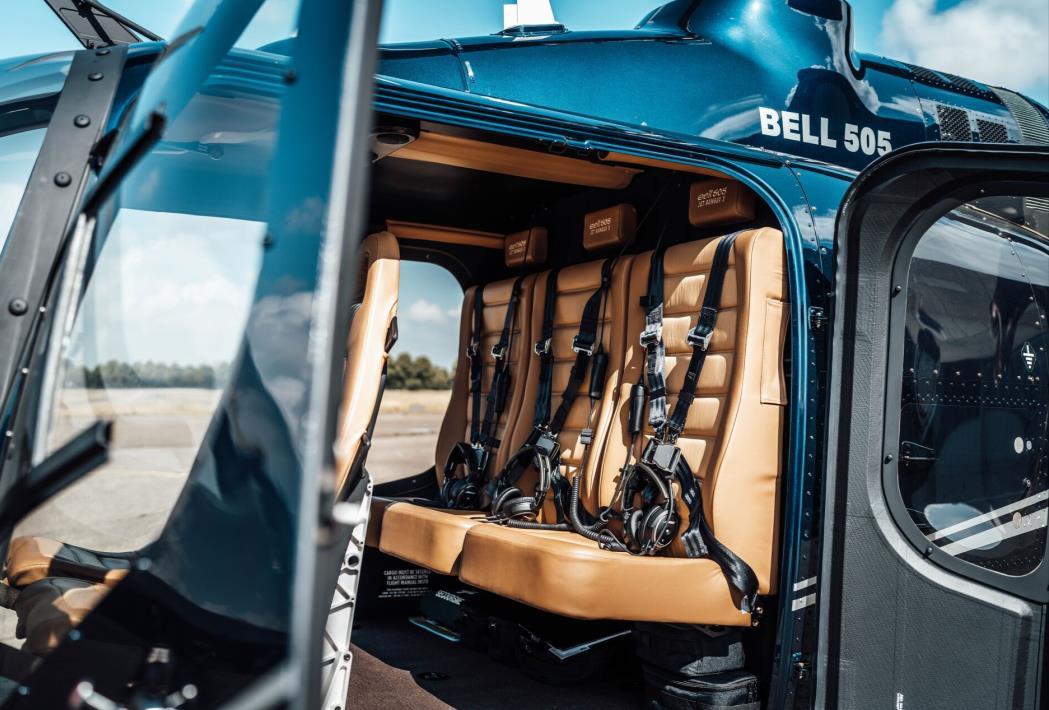
The 505 is assembled at the Bell Helicopter plant in Mirabel, Quebec, Canada.
The single-engine 505 uses a two-blade rotor powered by a dual FADECcontrolled Arrius 2R turboshaft engine from Safran. The cabin frame is mostly aluminum, and the roof and sides of the cabin are composite. The cockpit features Garmin G1000H NXi avionics suite, configured with two 10.4-inch LCD screens. Optional features include Garmin HSVT™ (Helicopter Synthetic Vision Technology).
PERFORMANCE Range 306 nm Max Endurance 3.9 hrs Max Cruise Speed 125 kts Economy Cruise Speed 112 kts Service Ceiling 18,610 ft Hover IGE Ceiling 14,450 ft Hover OGE Ceiling 10,460 ft WEIGHTS Max Takeoff 3,680 lbs Basic Operating 2,180 lbs Max Payload 1,500 lbs Usable Fuel 569 lbs SYSTEMS AVIONICS Manufacturer Garmin Model G3000H Nxi ENGINES Number of Engines 1 Manufacturer Safran Helicopter Engines Model Arrius 2R Takeoff Power 505 shp Max Continuous Power 459 shp CABIN Max Passengers 4 Cabin Height 4.4 ft Cabin Width 4.7 ft Cabin Length 2.75 ft Cabin Volume 61 cu.ft Baggage Compartment 18 cu.ft
CATEGORY:
ELITE WINGS MAGAZINE |
CATEGORY:
AIRBUS | ACH125
The ACH125 / H125 started its career as the French manufacturer Eurocopter AS350 Ecureuil “Squirrel” model. This highly successful singleengine helicopter first flew on June 27, 1974, prior to entering service in March 1978. Originally assembled in the Marignane facility near Marseille, France. Airbus Helicopter decided in 2013 to add an H125 line to their Columbus, Mississippi production site. Powered by a single FADEC-controlled Safran Arriel 2D Engine and a threeblade main rotor, the H125 broke the record for the highest altitude landing and take-off performed on Mount Everest, Himalaya at 29,029 feet. The flight deck features a glass touchscreen cockpit instrument panel with Garmin G500H TXi and a Vehicle & Engine Multifunction Display ® (VEMD), developed exclusively for Airbus.


SINGLE ENGINE
LIGHT
PERFORMANCE Range 349 nm Max Endurance 4hr 57min Max Cruise Speed 143 kts Economy Cruise Speed 137 kts Service Ceiling 23,000 ft Hover IGE Ceiling 11,600 ft Hover OGE Ceiling 9,450 ft WEIGHTS Max Takeoff 4,960 lbs Basic Operating 2,727 lbs Max Payload 2,233 lbs Usable Fuel 958 lbs SYSTEMS AVIONICS Manufacturer Garmin & Airbus Model G500H TXi ENGINES Number of Engines 1 Manufacturer Safran Helicopter Engines Model Arriel 2D Takeoff Power 802 shp Max Continuous Power 802 shp CABIN Max Passengers 5 Cabin Height 4 ft Cabin Width 5 ft Cabin Length 7 ft Cabin Volume 61 cu.ft Baggage Compartment 36 cu.ft | ELITE WINGS MAGAZINE
BELL| BELL 407GXi

The four-blade, single-engine Bell 407 is a derivative of the legendary 1960s-era Bell 206 Long Ranger. Combining the four-blade rotor architecture of its military derivative, the OH-58D (Kiowa Warrior), and an 8-inch wider fuselage. The Bell 407 completed its first flight on June 29, 1995, with full certification achieved in February 1996. The Bell 407 is renowned for its exceptional hot and high-performance capabilities. It is also certified for IFR operation. The latest Bell 407GXi version is powered by a single FADEC-controlled Rolls-Royce 250-C47E/4 engine and features the latest generation Garmin G1000H NXi integrated avionics. This flight deck update brings significant capabilities and advanced features such as wireless cockpit connectivity, enhanced situational awareness with SurfaceWatch, map overlay on the HSI, and more.

PERFORMANCE Range 337 nm Max Endurance 4 hrs Max Cruise Speed 133 kts Economy Cruise Speed 120 kts Service Ceiling 18,940 ft Hover IGE Ceiling 13,550 ft Hover OGE Ceiling 11,940 ft WEIGHTS Max Takeoff 5,000 lbs | Standard 5,250 lbs | Optional Basic Operating 2,700 lbs Max Payload 2,300 lbs | Standard 2,550 lbs | Optional Usable Fuel 856 lbs SYSTEMS AVIONICS Manufacturer Garmin Model G1000H NXi ENGINES Number of Engines 1 Manufacturer Rolls-Royce Model 250-C47E/4 Takeoff Power 862 shp Max Continuous Power 761 shp CABIN Max Passengers 6 Cabin Height 3.8 ft Cabin Width 3.9 ft Cabin Length 5 ft Cabin Volume 85 cu.ft Baggage Compartment 16 cu.ft CATEGORY: LIGHT
ENGINE ELITE WINGS MAGAZINE |
SINGLE
AIRBUS | ACH130
The ACH130 is the corporate version of the H130 previously known as the Eurocopter EC130. This light single-engine helicopter was developed by the French manufacturer from the AS350 (H125) Ecureuil “Squirrel” with the introduction of an integrally enclosed anti-torque tail rotor device called FENESTRON and an automatically varying three-bladed Starflex main rotor. The H130 first flew on June 24, 1999, prior to entering service in 2001. The H130 was designed more for passengers, aerial tours, and scenic views market segment in comparison with the more utility-oriented H125. The H130 offers excellent external visibility combined with the largest cabin of any single-engine helicopter. In 2020, Airbus Corporate Helicopters introduced the ACH130 Aston Martin edition. A stylish special edition featuring four interior and exterior designs generated by Aston Martin.

CATEGORY: LIGHT

SINGLE ENGINE
PERFORMANCE Range 347 nm Max Endurance 4hr 13 min Max Cruise Speed 134 kts Economy Cruise Speed 120 kts Service Ceiling 23,000 ft Hover IGE Ceiling 18,085 ft Hover OGE Ceiling 9,675 ft WEIGHTS Max Takeoff 5,512 lbs Basic Operating 3,113 lbs Max Payload 2,399 lbs Usable Fuel 958 lbs SYSTEMS AVIONICS Manufacturer Garmin / Airbus Model G500H TXi ENGINES Number of Engines 1 Manufacturer Safran Helicopter Engines Model Arriel 2D Takeoff Power 802 shp Max Continuous Power 802 shp CABIN Max Passengers 6 Cabin Height 6 ft Cabin Width 4 ft Cabin Length 7 ft Cabin Volume 131 cu.ft Baggage Compartment 40 cu.ft | ELITE WINGS MAGAZINE
LEONARDO| AW119Kx
The AW119 is a light single-engine derivative of the twin-engine AW109 manufactured by the helicopter division of the Italian aerospace conglomerate Leonardo. The AW119 entered service in 2009 as a lowerpriced helicopter compared to the AW109 with whom it shares the cockpit and the cabin design. The Italian-designed airplane is assembled in Leonardo facility in Philadelphia, USA, with a fuselage structure manufactured in Poland. The AW119Kx (K for the old designation Koala) and x for the Garmin G1000 NXi equipped flight deck is the latest iteration of the model. The new glass cockpit offers enhanced situational awareness and brings a large set of advanced navigation and safety features. On July 16th, 2019, the AW119 received its IFR certification from the Federal Aviation Administration (FAA).


LIGHT SINGLE ENGINE PERFORMANCE Range 510 nm Max Endurance 5h16 min Max Cruise Speed 131 kts Economy Cruise Speed 117 kts Service Ceiling 15,000 ft Hover IGE Ceiling 11,000 ft Hover OGE Ceiling 7,300 ft * 24,000 ft with envelope extension - EASA Certified WEIGHTS Max Takeoff 6,283 lbs Basic Operating 3,704 lbs Max Payload 2,579 lbs Usable Fuel 1,513 lbs SYSTEMS AVIONICS Manufacturer Garmin or Genesys Aerosystems (IFR) Model G1000 NXi or IDU-680 ENGINES Number of Engines 1 Manufacturer Pratt & Whitney Canada Model PT6B-37A Takeoff Power 917 shp Max Continuous Power 847 shp CABIN Max Passengers 7 Cabin Height 4 ft 02 in Cabin Width 5 ft 03 in Cabin Length 6 ft 10 in Cabin Volume 121.84 cu.ft Baggage Compartment 33.55 cu.ft
CATEGORY:
LEONARDO | AW09
The AW09 is the only single-engine product in the last four decades with an all-new design. Engineered using the latest technologies and high-tech materials, the AW09 is setting a new reference in its category, featuring a crashworthy composite structure and fuel tank, IFR-compatible Garmin G3000H avionics suite, gearbox innovative designs, low vibration main rotor, and low noise signature shrouded tail rotor architecture. The modularity of the cabin makes the most of the flat floor, the largest cabin volume in its class, and the unique high ceiling concept. It offers multiple interion arrangements with 5, 6, and up to 8 occupants, crashworthy passenger seats (plus pilot), and unobstructed rear access loading through the clamshell doors for baggage. The AW09 is planned to enter service in 2024.
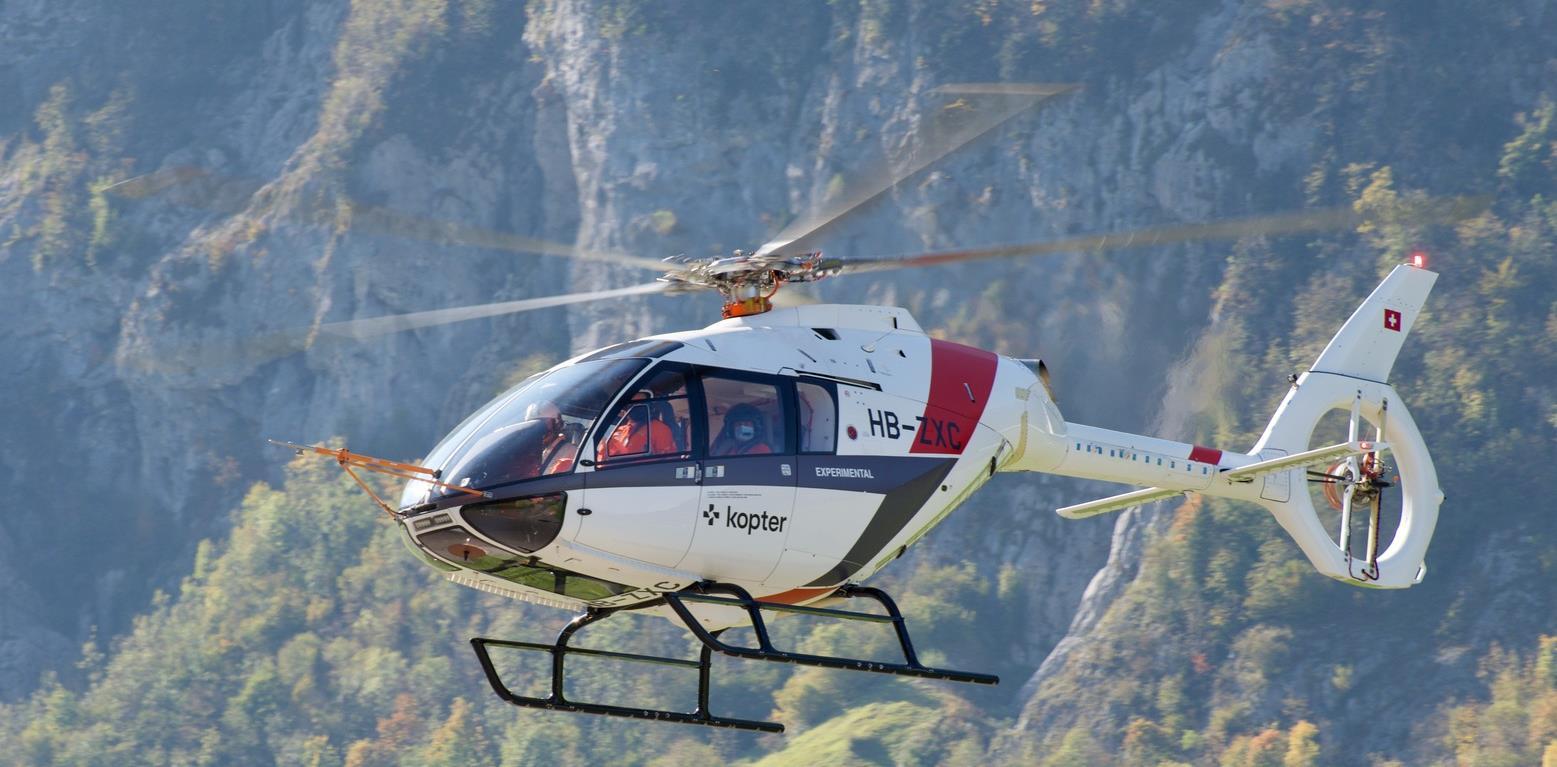

ENGINE
CATEGORY: LIGHT SINGLE
PERFORMANCE Range > 430 nm Max Endurance > 5 h Max Cruise Speed 0 Economy Cruise Speed 140 kts Service CeilingHover IGE Ceiling 0 Hover OGE Ceiling N/A WEIGHTS Max Takeoff 6,283 lbs Basic Operating N/A Max Payload N/A Usable Fuel N/A SYSTEMS AVIONICS Manufacturer Garmin Model G3000H ENGINES Number of Engines 1 Manufacturer Safran Helicopter Engines Model Arriel 2K Takeoff Power 1,006 shp Max Continuous Power N/A CABIN Max Passengers 8 Cabin Height N/A Cabin Width N/A Cabin Length N/A Cabin Volume 230 cu.ft Baggage Compartment (Included in cabin) | ELITE WINGS MAGAZINE IN DEVELOPMENT
AIRBUS| ACH135
The ACH135 is the corporate version of the twin-engine H135 helicopter previously marketed under the Eurocopter EC135 designation. The development of the H135 started, as a German Messerschmitt-BölkowBlohm (MBB) design prior to Eurocopter formation in 1992.


The H135 completed its first flight on February 15, 1994, prior to entering service in 1996.
The H135 offers a dual-engine selection and can be equipped with either two Pratt & Whitney Canada PW206B3 engines or two Safran Arrius 2B2plus, both are FADEC controlled. The H135 is also equipped with Airbus’ signature FENESTRON shrouded tail rotor. Designed primarily for the Emergency Medical Service (EMS), the H135 features a large EMS-optimized cabin providing ample room for patient care.
PERFORMANCE Range 349 nm Max Endurance 4hr 46 min Max Cruise Speed 139 kts Economy Cruise Speed 134 kts Service Ceiling 20,000 ft Hover IGE Ceiling 12,750 ft Hover OGE Ceiling 7,200 ft WEIGHTS Max Takeoff 6,570 lbs Basic Operating 3,267 lbs Max Payload 3,124 lbs Usable Fuel 1,249 lbs SYSTEMS AVIONICS Manufacturer
Model
ENGINES Number of Engines 2 Manufacturer
Model
Takeoff Power 633 shp
451 shp Max Continuous Power 580 shp
435 shp CABIN Max Passengers 6 Cabin Height 5 ft Cabin Width 4 ft Cabin Length 11 ft Cabin Volume 141 cu.ft Baggage Compartment 32 cu.ft CATEGORY: LIGHT TWIN ENGINE
Airbus Helicopters
Helionix Avionics Suite
Safran Helicopter Engines or Pratt & Whitney Canada
Arrius 2B2 Plus |PW206B3
|
|
LEONARDO | AW109 Trekker

The Light twin-engine AW109 is one of the most popular offerings from the helicopter division of the Italian aerospace conglomerate Leonardo. This twin-engine helicopter has always been very appreciated in the VIP/Corporate market where over 50% of the fleet is still serving today. The original version of the AW109 first flew on August 4, 1971, before entering service in 1976. Since then, the AW109 has gone through a long series of avionics and engine enhancements. The AW109 Trekker is the latest updated version, based on the AW109 Grand lengthened cabin and featuring a pair of FADEC-equipped Pratt & Whitney Canada PW207C engines together with an enhanced avionics configuration from Genesys Aerosystems allowing for single-pilot IFR. The AW109 Trekker fixed landing skids make it particularly suitable for landing on yachts.
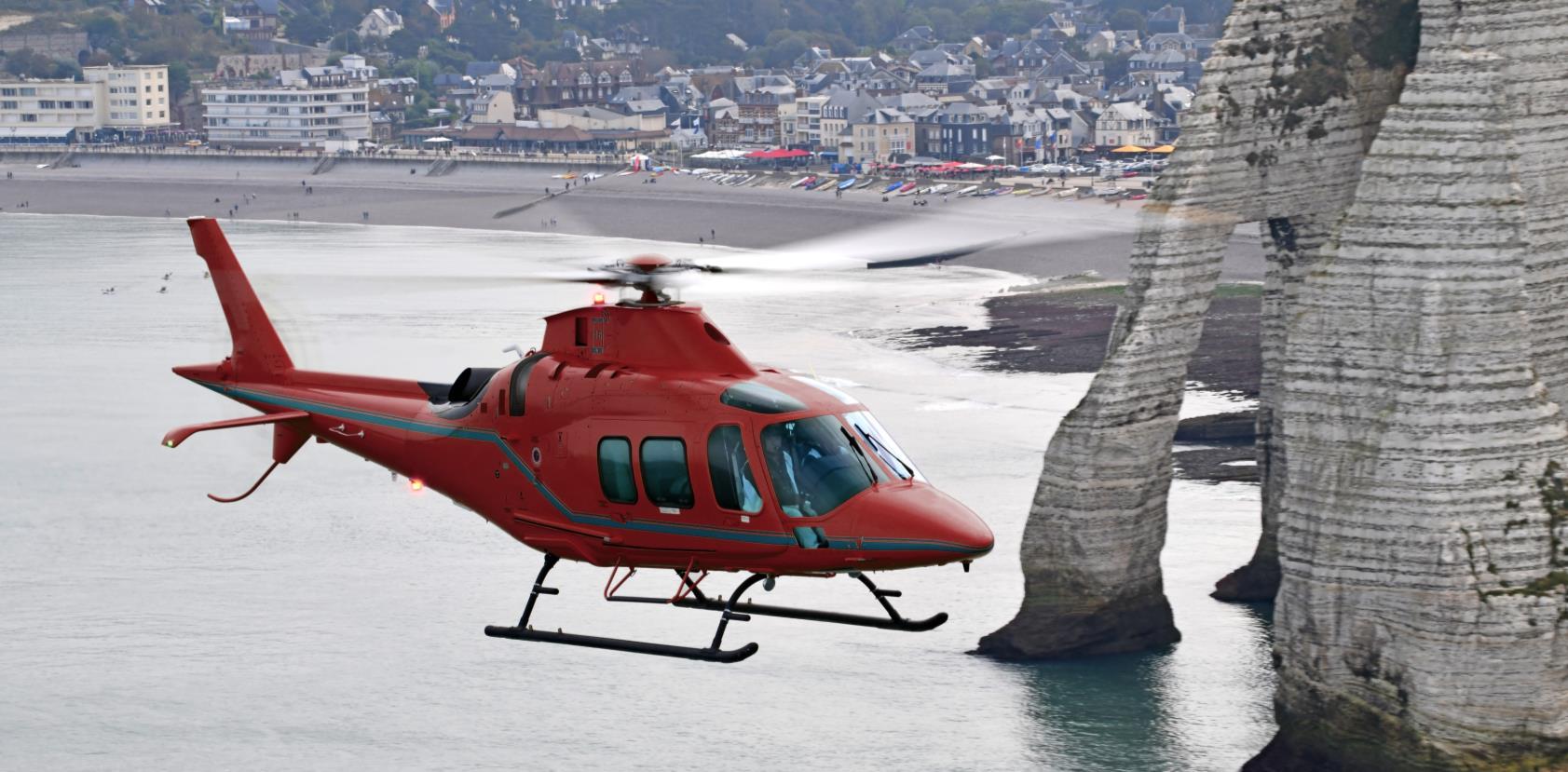
TWIN ENGINE
CATEGORY: LIGHT
PERFORMANCE Range 440 nm Max Endurance 4h13 min Max Cruise Speed 152 kts Economy Cruise Speed 126 kts Service Ceiling 20,000 ft Hover IGE Ceiling 15,120 ft Hover OGE Ceiling 9,600 ft WEIGHTS Max Takeoff 7,000 lbs Basic Operating 4,101 lbs Max Payload 2,899 lbs Usable Fuel 1,398 lbs SYSTEMS AVIONICS Manufacturer Genesys Aerosystems Model IDU-680 ENGINES Number of Engines 2 Manufacturer Pratt & Whitney Canada Model PW207C Takeoff Power 735 shp Max Continuous Power 625 shp CABIN Max Passengers 7 Cabin Height 4 ft 02 in Cabin Width 5 ft 03 in Cabin Length 7 ft 07 in Cabin Volume 137.7 cu.ft Baggage Compartment 30.4 cu.ft | ELITE WINGS MAGAZINE
LEONARDO| AW109 GrandNew

The Light twin-engine AW109 is one of the most popular offerings from the helicopter division of the Italian aerospace conglomerate Leonardo. This twin-engine helicopter has always been very appreciated in the VIP/Corporate market where over 50% of the fleet is still serving today. The original version of the AW109 first flew on August 4, 1971, before entering service in 1976. Since then, the AW109 has gone through a long series of avionics and engine enhancements. The AW109 GrandNew is the latest updated version, featuring a pair of FADEC-equipped Pratt & Whitney Canada PW207C engines together with enhanced avionics from Genesys Aerosystems The cabin can be arranged in a variety of configurations, ranging from a luxurious four-seat to a comfortable six-seat configuration complemented by wide sliding doors and electrically retractable steps.

CATEGORY: LIGHT TWIN ENGINE PERFORMANCE Range 442 nm Max Endurance 4h14 min Max Cruise Speed 156 kts Economy Cruise Speed 132 kts Service Ceiling 20,000 ft Hover IGE Ceiling 15,600 ft Hover OGE Ceiling 10,000 ft WEIGHTS Max Takeoff 7,000 lbs Basic Operating 4,365 lbs Max Payload 2,638 lbs Usable Fuel 1,398 lbs SYSTEMS AVIONICS Manufacturer Genesys Aerosystems Model IDU-450 ENGINES Number of Engines 2 Manufacturer Pratt & Whitney Canada Model PW207C Takeoff Power 735 shp Max Continuous Power 625 shp CABIN Max Passengers 7 Cabin Height 4 ft 02 in Cabin Width 5 ft 03 in Cabin Length 7 ft 07 in Cabin Volume 137.7 cu.ft Baggage Compartment 31.8 cu.ft
CATEGORY:
BELL | BELL 429
The Bell 429 first flew on February 27, 2007, prior to entering service in 2009. The 429 carries the external lines of Bell’s legendary 206 Jet Ranger with an all-new wider airframe especially optimized for Emergency Medical Services (EMS) configuration. Powered by two Pratt & Whitney PW 207D1 turboshaft engines, the design of the 429 features a four-composite bladed rotor, a composite and aluminum structure for a two-person crew and up to six passengers, standard landing skids, and optional retractable landing gear for convenient taxiing.
The Bell 429 offers a higher design weight IGW version which is not FAA certified but can be certified in over twelve countries outside the USA.

The Bell 429 is Single-pilot IFR certified and features the Bell-designed BasiX Pro flight deck.
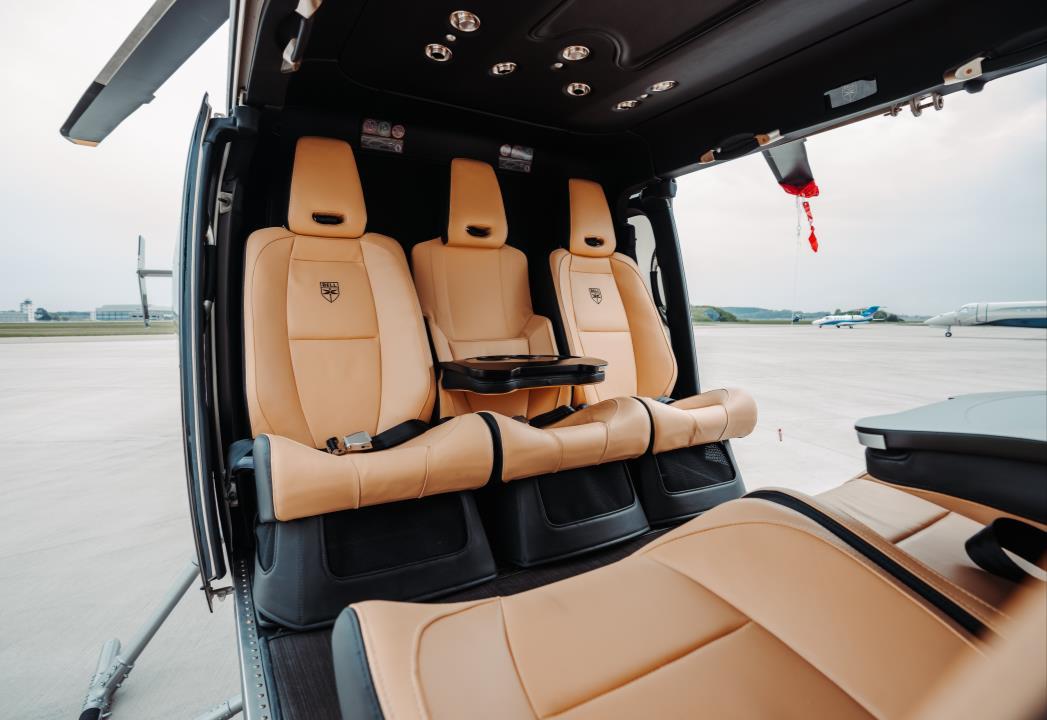
TWIN
PERFORMANCE Range 372 nm Max Endurance 4.1 hrs Max Cruise Speed 150 kts Economy Cruise Speed 130 kts Service Ceiling 18,710 ft Hover IGE Ceiling 14,130 ft Hover OGE Ceiling 11,290 ft WEIGHTS Max Takeoff 7,000 lbs | Standard 7,500 lbs | IGW Basic Operating 4,465 lbs Max Payload 2,535 lbs | Standard 3,014 lbs | IGW Usable Fuel 1,453 lbs SYSTEMS AVIONICS Manufacturer Bell Model BasiX Pro 2nd Gen with GTN-650/750 ENGINES Number of Engines 2 Manufacturer Pratt & Whitney Canada Model PW207D1/D2 Takeoff Power 719 shp Max Continuous Power 635 shp CABIN Max Passengers 7 Cabin Height 4.1 ft Cabin Width 5 ft Cabin Length 6.6 ft Cabin Volume 204 cu.ft Baggage Compartment 74 cu.ft | ELITE WINGS MAGAZINE
LIGHT
ENGINE
INTERMEDIATE
7,000 lbs < MTOW < 10,000 lbs
The Intermediate category combines light helicopter versatility with increased cabin size and range capabilities making them perfect for a large number of missions ranging from Emergency Medical Services to Search & Rescue and offshore operations.

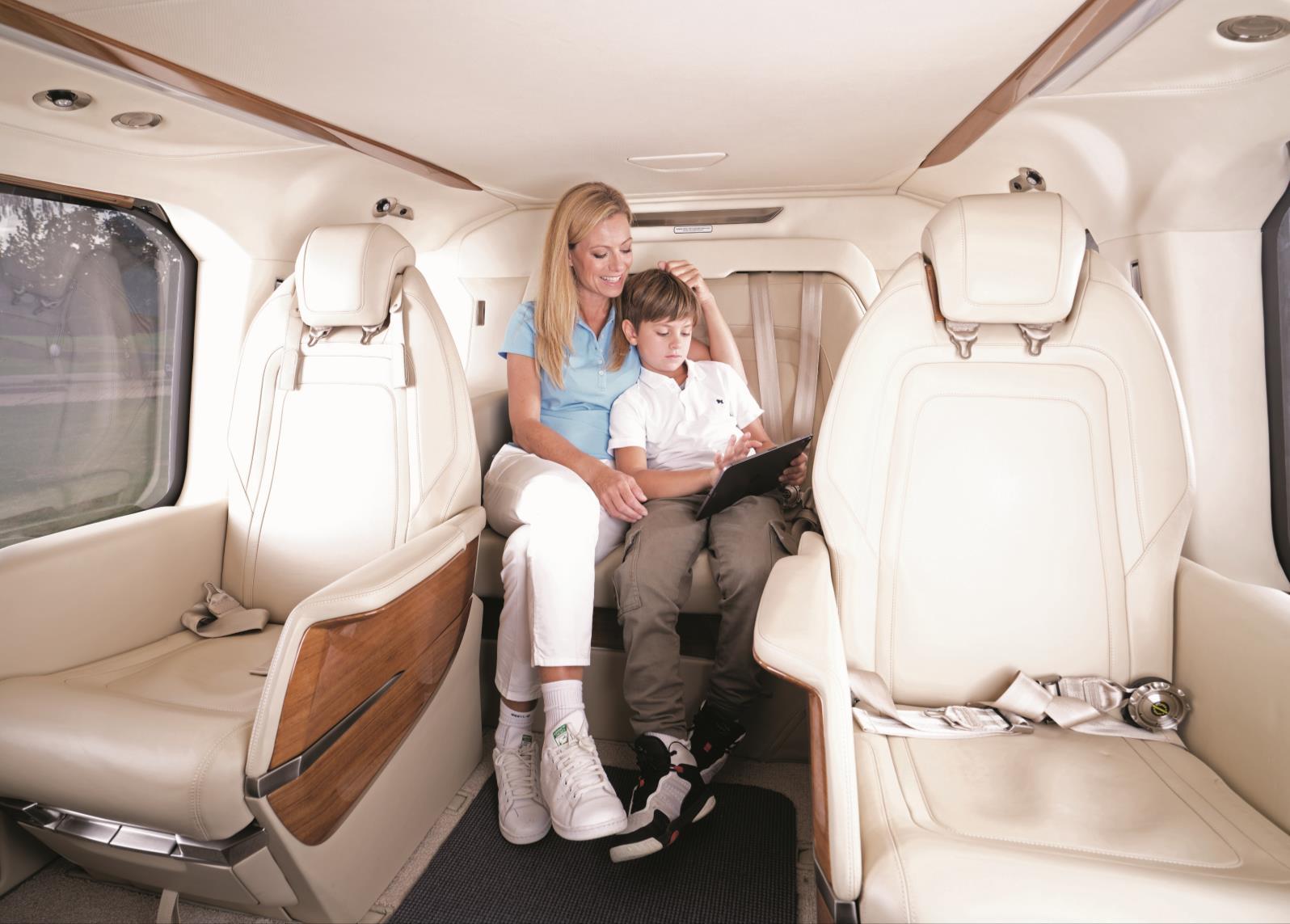
ELITE WINGS MAGAZINE |
ACH145 MERCEDES-BENZ STYLE
AW169 Passenger Cabin ©Leonardo
CATEGORY:
AIRBUS | ACH145
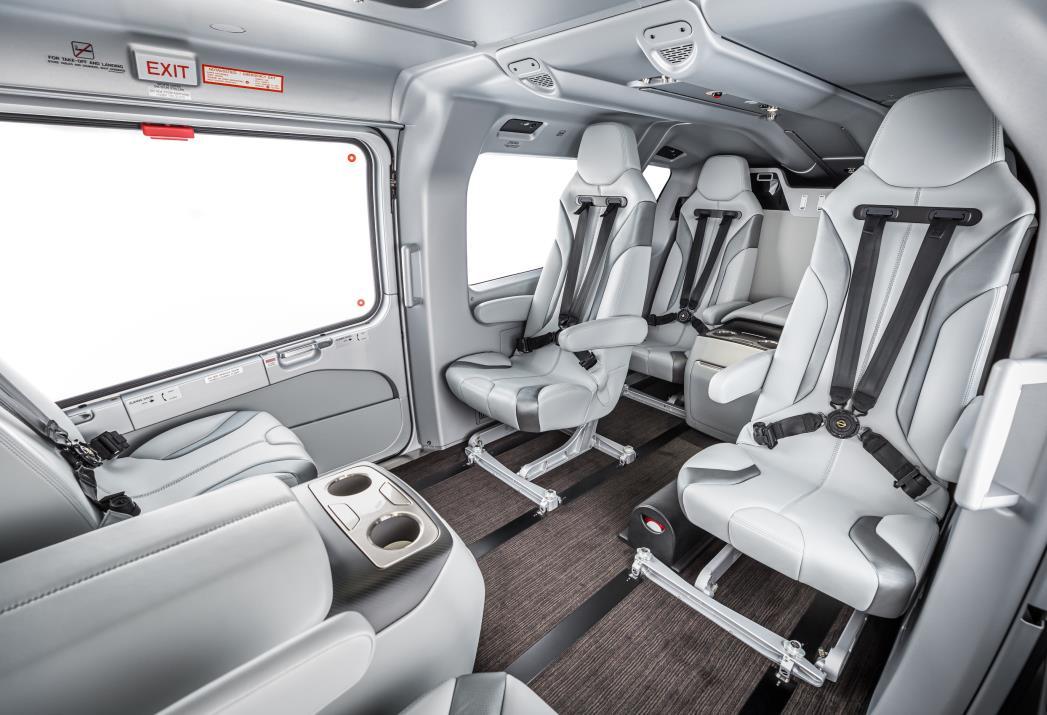
The ACH145 is the corporate version of the twin-engine H145 helicopter previously marketed under the Eurocopter EC145 designation. Developed under a joint program between Europe-based Eurocopter and Japan Kawasaki Heavy Industries, the EC145 was aimed to replace the previous MBB/Kawasaki BK117 joint helicopter program. The H145 completed its first flight on June 12, 1999, prior to entering service in 2002. The H145 was primarily designed for aerial rescue missions requiring high endurance and payload capability. The EC145 combines the forward cockpit and modern avionics of Eurocopter’s EC135 with the proven BK117’s rear section. The H145 is powered by twin FADEC-controlled Safran Arriel 2E engines. In 2020 the H145 was further improved with the addition of a new five-bladed rotor, increasing the useful load by 330 lb.

INTERMEDIATE
PERFORMANCE Range 366 nm Max Endurance 3hr 55min Max Cruise Speed 137 kts Economy Cruise Speed 132 kts Service Ceiling 20,000 ft Hover IGE Ceiling 12,900 ft Hover OGE Ceiling 9,700 ft WEIGHTS Max Takeoff 8,157 lbs Basic Operating 4,486 lbs Max Payload 3,926 lbs Usable Fuel 1,625 lbs SYSTEMS AVIONICS Manufacturer Airbus Helicopters Model Helionix Avionics Suite ENGINES Number of Engines 2 Manufacturer Safran Helicopter Engines Model Arriel 2E Takeoff Power 667 shp Max Continuous Power 575 shp CABIN Max Passengers 9 Cabin Height 4 ft Cabin Width 6 ft Cabin Length 13 ft Cabin Volume 166 cu.ft Baggage Compartment 47 cu.ft | ELITE WINGS MAGAZINE
LEONARDO| AW169
The AW169 is the latest generation offering from Leonardo in the 4 5metric tonnes segment. This ten-seat twin-engines helicopter carries a large design commonality with its bigger siblings the Medium size AW139 and Super-Medium AW189 Launched in 2010, the AW169 first flew on May 10, 2012, before entering service in 2016. The AW169 is powered by a pair of Pratt & Whitney Canada PW210A FADEC controlled turboshaft engines and incorporates a large selection of advanced capabilities such as a fully tested 33 minutes “run-dry” capable main gearbox and a unique Auxiliary Power Unit (APU) mode ensuring mission-readiness with stopped rotors for enhanced ground operations safety The flight deck features advanced Collins Aerospace integrated avionics configured with three 13-inch displays (AMLCD), dual touch screens, and a 4-axis dual digital autopilot system.

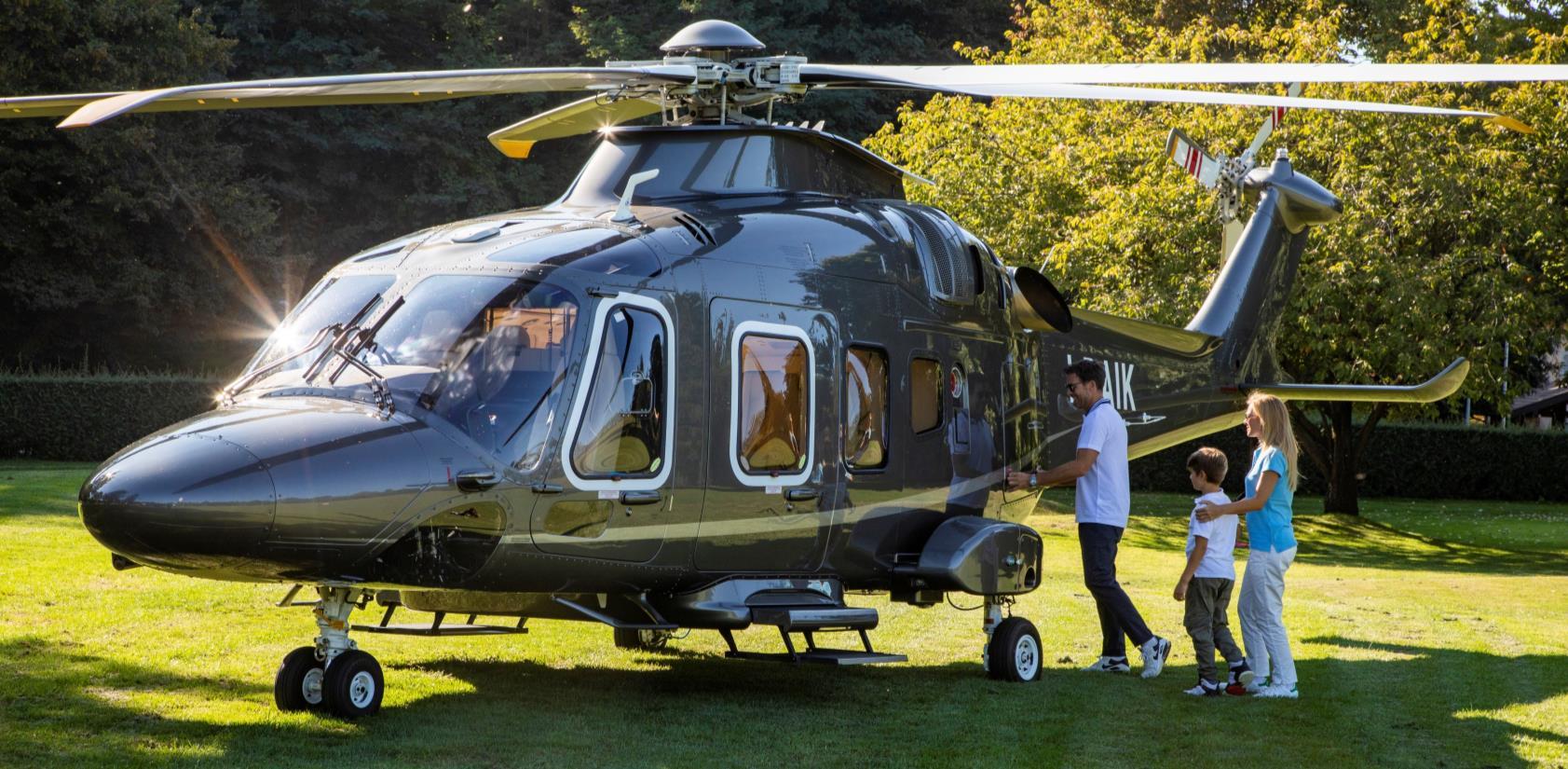
CATEGORY: INTERMEDIATE PERFORMANCE Range 424 nm Max Endurance 4h14 min Max Cruise Speed 141 kts Economy Cruise Speed 129 kts Service Ceiling 20,000 ft Hover IGE Ceiling 15,000 ft Hover OGE Ceiling 13,368 ft WEIGHTS Max Takeoff 10,141 lbs Basic Operating 6,283 lbs Max Payload 3,858 lbs Usable Fuel 1,958 lbs SYSTEMS AVIONICS Manufacturer Leonardo Helicopters Model N/A ENGINES Number of Engines 2 Manufacturer Pratt & Whitney Canada Model PW210A1 Takeoff Power 1,175 shp Max Continuous Power 920 shp CABIN Max Passengers 8 Cabin Height 4 ft 04 in Cabin Width 6 ft 08 in Cabin Length 7 ft 01 in Cabin Volume 222.5 cu.ft Baggage Compartment 48.44 cu.ft ELITE WINGS MAGAZINE |
MEDIUM & SUPER MEDIUM
10,000 lbs < MTOW < 20,000 lbs
Developed primarily to support the offshore oil and gas industry, the Medium and Super-Medium category helicopters have proven very popular in corporate transportation applications as their large and unobstructed cabins can embody the hallmarks of elegance, style, and sophistication. These helicopters can often be equipped with state-of-the-art telecommunications and entertainment systems, dedicated workspaces, and refreshment and stowage areas.

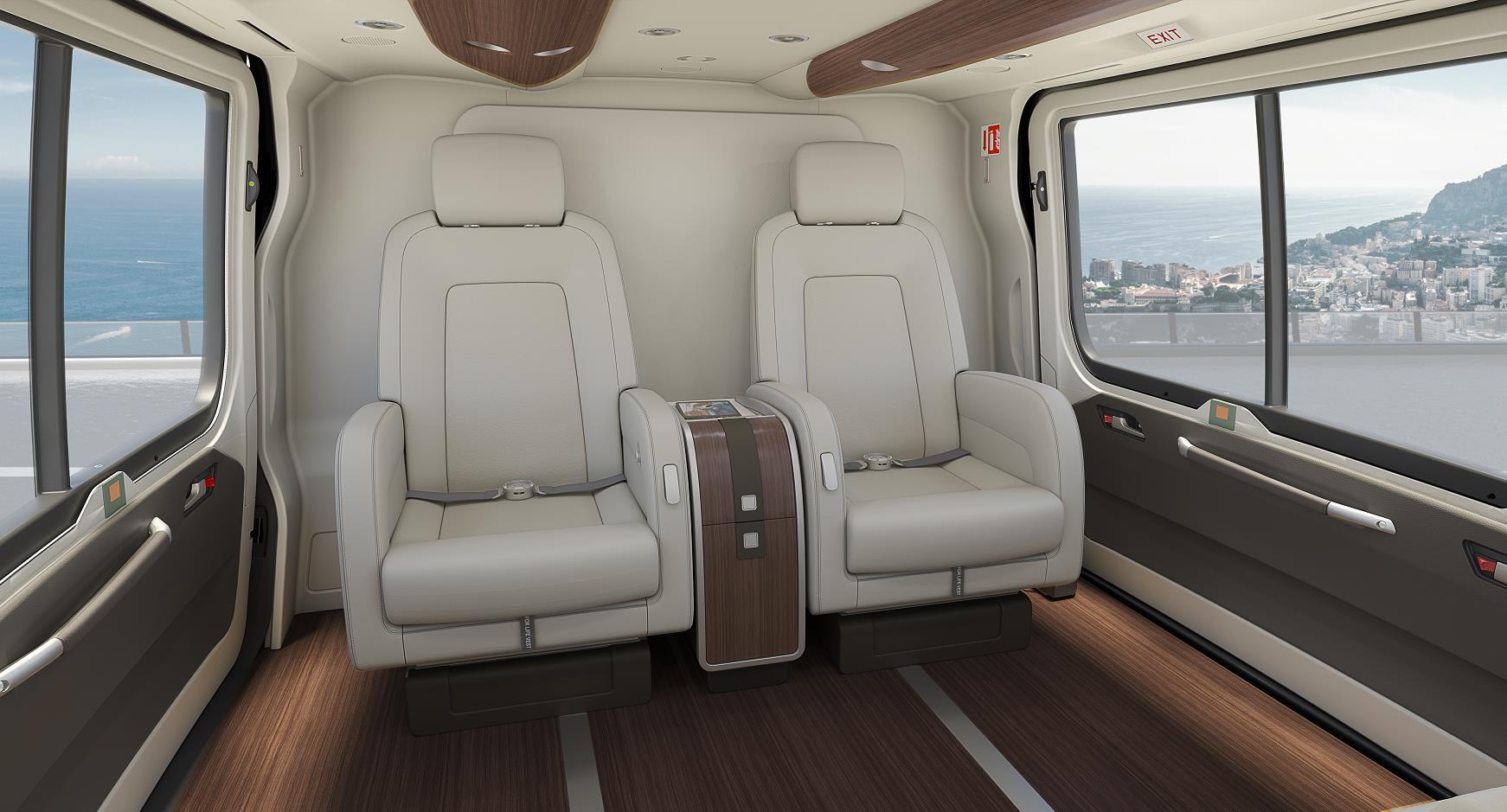
|
MAGAZINE
ELITE WINGS
ACH160
AW139 Cabin ©Leonardo
Cabin rendering ©Airbus
SIKORSKY| S-76D
The S-76 was the first Sikorsky helicopter designed solely for non-military usage and aimed primarily at the corporate and offshore oil and gas transportation markets. The original S-76 first flew on March 13, 1977, before entering service in 1979, establishing at that time several world records for range, climb, speed, and ceiling capabilities.
The latest S-76 model designed S-76D first flew on February 7, 2009, and entered service in 2012, powered by two 1,050-horsepower Pratt & Whitney Canada PW210S turboshaft engines driving a redesigned fourbladed fully articulated main rotor. The S-76D flight deck features Thales TopDeck avionics suite with four integrated displays.
In 2022, Sikorsky announced halting taking orders for the S-76D due to high production costs and low profitability.
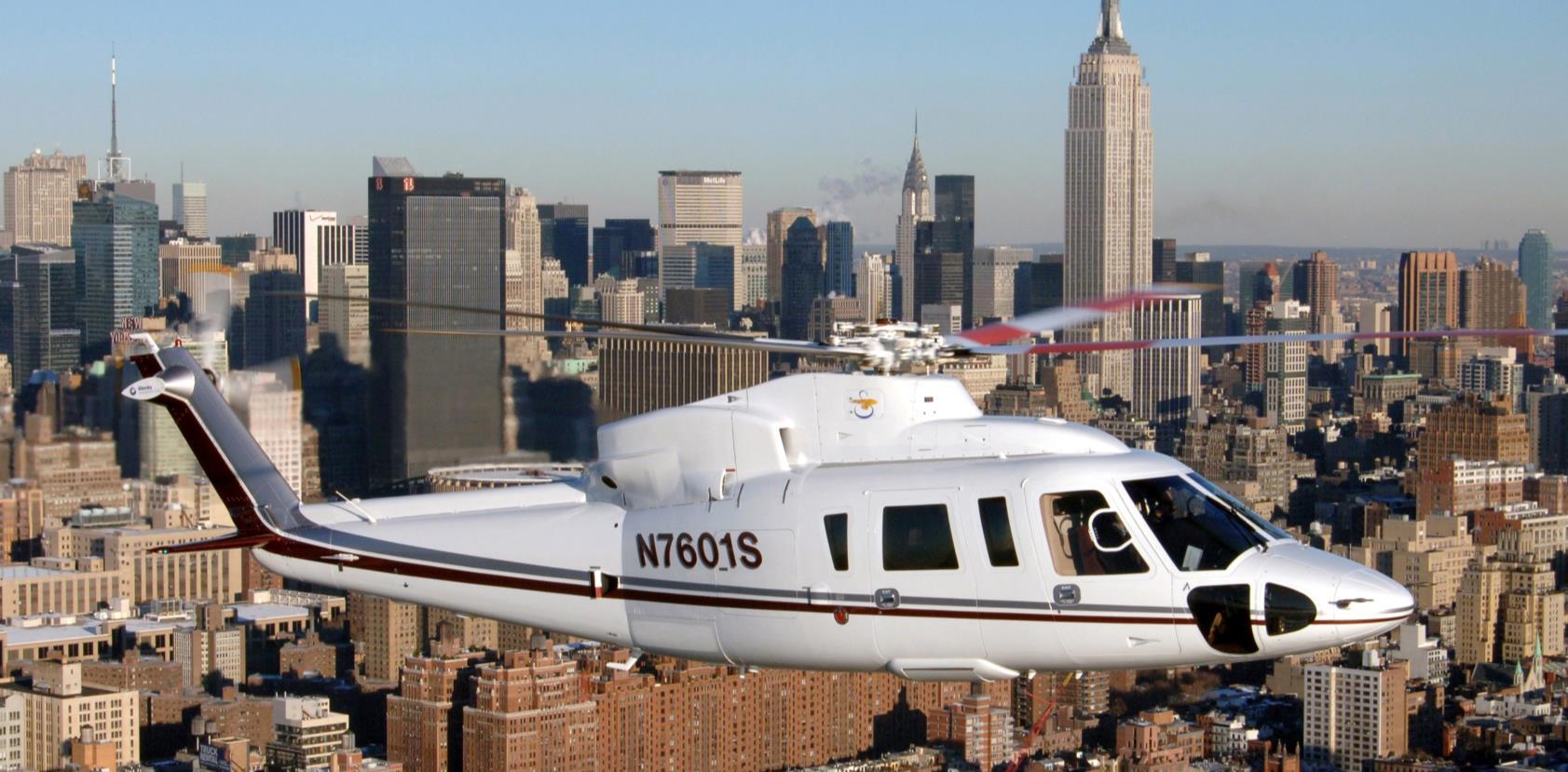

PERFORMANCE Range 472 nm Max EnduranceMax Cruise Speed 155 kts Economy Cruise Speed 152 kts Service Ceiling 15,000 ft Hover IGE Ceiling 10,540 ft Hover OGE Ceiling 4,930 ft WEIGHTS Max Takeoff 11,875 lbs Basic Operating 6,973 lbs Max Payload 4,912 lbs Usable Fuel 1,991 lbs SYSTEMS AVIONICS Manufacturer Thales Model TopDeck avionics suite ENGINES Number of Engines 2 Manufacturer Pratt & Whitney Canada Model PW210S Takeoff Power 803 shp Max Continuous Power 803 shp CABIN Max Passengers 9 Cabin Height 6 ft Cabin Width 5 ft Cabin Length 8 ft Cabin Volume 204 cu.ft Baggage Compartment 38 cu.ft CATEGORY: MEDIUM ELITE WINGS MAGAZINE |
AIRBUS | ACH160
The ACH160 is the corporate version of the twin-engine Airbus H160 helicopter. The all-composite H160 launched in 2015, was designed as a replacement for the very popular “Dolphin” (AS365 and EC155) in the medium-class category. It completed its first flight in June 2015 prior to entering service in 2019. Primarily designed for the offshore oil and gas market in the twelve-passenger segment, the H160 incorporates a wide range of corrosion-resistant materials for long overseas operations. Powered by twin Safran Arrano turboshaft engines, the H160 is the first Airbus rotorcraft to feature the Blue Edge five-bladed main rotor. Further noise reduction is achieved through the Airbus signature canted FENESTRON. The H160 flight deck features the Helionix avionics suite with a total of four 10-inch multifunctional displays.


MEDIUM
CATEGORY:
PERFORMANCE Range 460 nm Max Endurance 4hr 30min Max Cruise Speed 155 kts Economy Cruise SpeedService Ceiling 20,000 ft Hover IGE CeilingHover OGE CeilingWEIGHTS Max Takeoff 13,338 lbs Basic Operating 8,929 lbs Max Payload 2,470 lbs Usable Fuel 2,469 lbs SYSTEMS AVIONICS Manufacturer Airbus Helicopters Model Helionix Avionics Suite ENGINES Number of Engines 2 Manufacturer Safran Helicopter Engines Model Arrano 1A Takeoff Power 1,280 shp Max Continuous PowerCABIN Max Passengers 10 Cabin HeightCabin WidthCabin LengthCabin Volume 230 cu.ft Baggage Compartment| ELITE WINGS MAGAZINE
CATEGORY:
LEONARDO| AW139

The AW139 is a medium-sized twin-engine helicopter developed by Leonardo. Initially launched as a joint development by helicopter leaders Bell and Agusta carrying Agusta-Bell AB139 designation. In 2005 Leonardo took over the full ownership of what will become one of the most successful commercial helicopters ever made. The first AW139 prototype completed its first flight on February 3, 2001, prior to entering service in December 2004 where it proved a large success, especially in the offshore oil & gas transportation market. The AW139 is powered by a pair of FADECcontrolled Pratt & Whitney Canada PT6C-67C turboshaft engines, driving a five-bladed fully articulated main rotor, with an unmatched 60-minute dryrun transmission. The flight deck features an advanced avionics suite from Honeywell with large displays enabling multiple enhanced safety features.
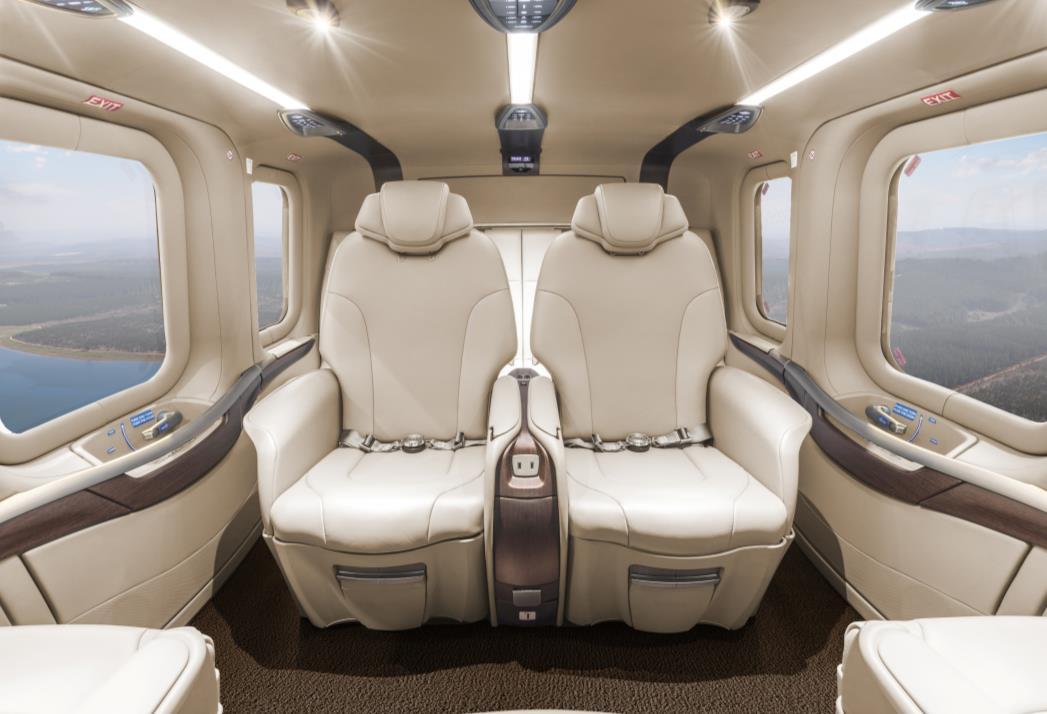
MEDIUM PERFORMANCE Range 573 nm Max Endurance 5h13 min Max Cruise Speed 165 kts Economy Cruise Speed 136 kts Service Ceiling 20,000 ft Hover IGE Ceiling 15,327 ft Hover OGE Ceiling 8,123 ft WEIGHTS Max Takeoff 14,110 lbs Basic Operating 8,378 lbs Max Payload 5,732 lbs Usable Fuel 2,765 lbs SYSTEMS AVIONICS Manufacturer Honeywell Model N/A ENGINES Number of Engines 2 Manufacturer Pratt & Whitney Canada Model PT6C-67C Takeoff Power 1,679 shp Max Continuous Power 1,531 shp CABIN Max Passengers 8 Cabin Height 4 ft 08 in Cabin Width 6 ft 11 in Cabin Length 8 ft 10 in Cabin Volume 282.52 cu.ft Baggage Compartment 120.07 cu.ft ELITE WINGS MAGAZINE |
AIRBUS | ACH175
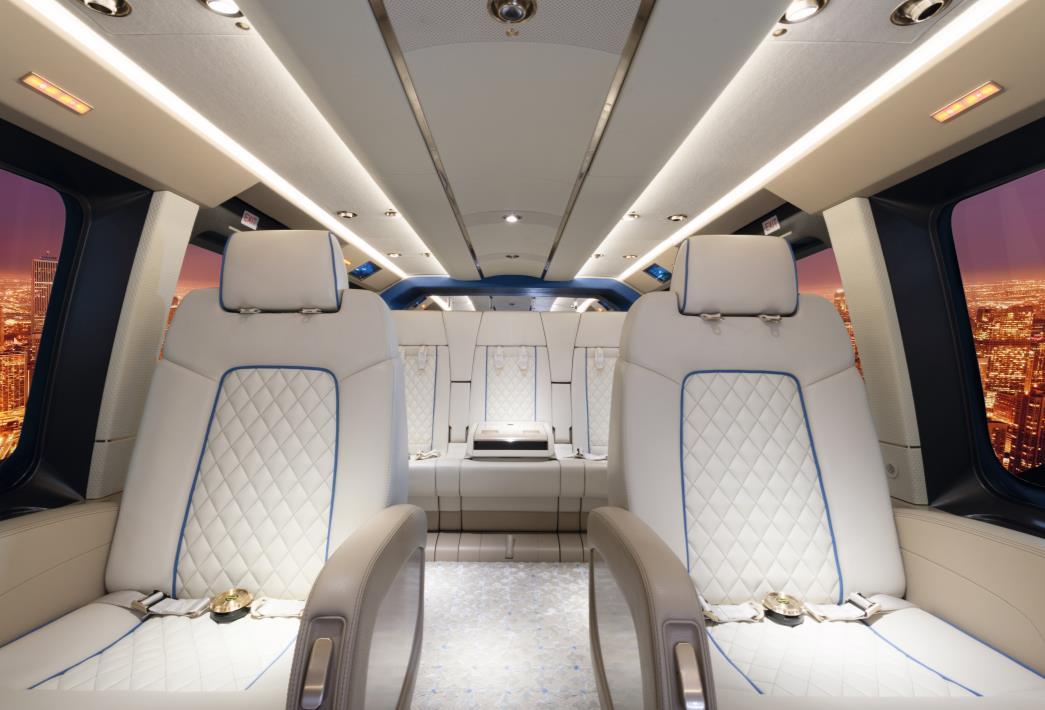
The H175 was primarily designed for the offshore oil and gas market in the new “super-medium” 7 metric tons class. The program was jointly developed by Airbus Helicopters and the Chinese aerospace conglomerate AVIC. Launched in 2008, the H175 completed its first flight on December 17, 2009, prior to entering service in December 2014 with Belgian operator NHV for offshore oil and gas operations in the north-sea oil rigs. The Airbus Helicopters-built H175 is powered by two FADEC-controlled Pratt & Whitney Canada PT6C-67E Engines whereas the Chinese-built helicopters are powered by a Joint Safran / AVIC co-developed Ardiden 3C/WZ16 engines. The H175 flight deck features the Airbus Helicopter’s inhouse developed Helionics avionics suite with a total of four 10-inch multifunctional displays.
CATEGORY: SUPER-MEDIUM
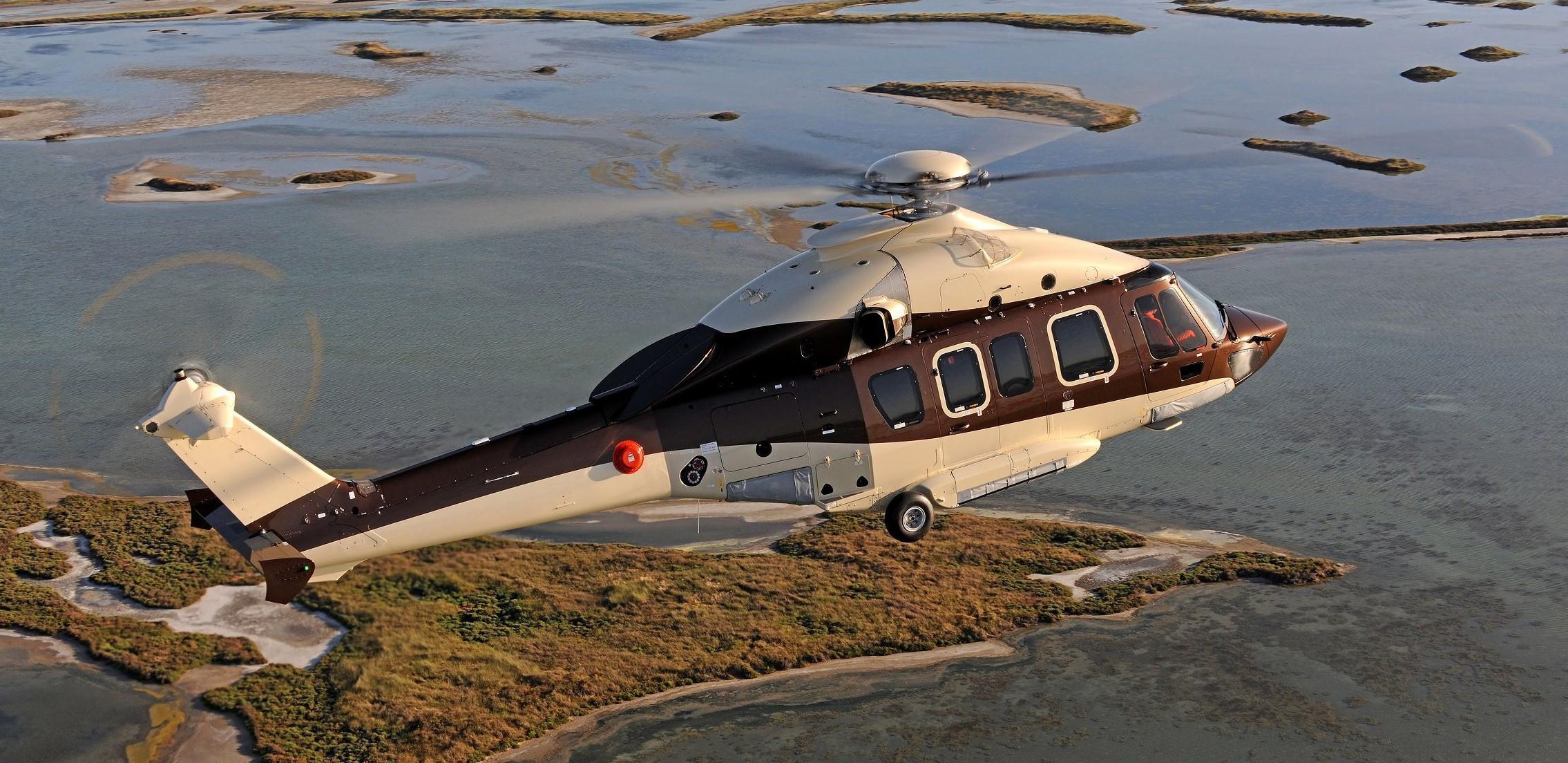
PERFORMANCE Range 613 nm Max Endurance 4hr 30min Max Cruise Speed 151 kts Economy Cruise Speed 140 kts Service Ceiling 18,000 ft Hover IGE Ceiling 14,029 ft Hover OGE Ceiling 9,744 ft WEIGHTS Max Takeoff 17,196 lbs Basic Operating 7,750 lbs Max Payload 8,785 lbs Usable Fuel 4,555 lbs SYSTEMS AVIONICS Manufacturer Airbus Helicopters Model Helionix Avionics Suite ENGINES Number of Engines 2 Manufacturer Pratt & Whitney Canada Model PT6C-67E Takeoff Power 1,774 shp Max Continuous Power 1,645 shp CABIN Max Passengers 12 Cabin Height 7 ft Cabin Width 5 ft Cabin Length 13 ft Cabin Volume 434 cu.ft Baggage Compartment 95 cu.ft | ELITE WINGS MAGAZINE
CATEGORY:
LEONARDO| AW189

The AW189 is a Super Medium twin-engine helicopter manufactured by Leonardo. Developed from the AW139 for the 8-metric tons, long-range, 19-passenger segment, it proved popular with the offshore oil & gas market where the AW189 is able to economically replace low performance older generation heavier helicopters. Launched in 2011, the AW189 completed its first flight on December 21, 2011, prior to entering service in 2015 with launch customer Bristow for operation in the North Sea offshore oil rigs. Powered by either dual FADEC-controlled Safran Aneto-1K Turboshafts or General Electric CT7-2E1 Turboshafts installation, the AW189 features an Industry-leading 50 minutes ‘dry-run’ capable main gearbox and a 60KW Auxiliary Power Unit (APU) from Safran

PERFORMANCE Range 413 nm (GE Engines) 374 nm (Safran Engines) Max Endurance 3h 49 min (GE Engines) 3h 23 min (Safran Engines) Max Cruise Speed 155 kts Economy Cruise Speed 127 kts (GE Engines) 135 kts (Safran Engines) Service Ceiling 15,000 ft Hover IGE Ceiling 12,953 ft (GE Engines) 15,000 ft (Safran Engines) Hover OGE Ceiling 9,490 ft (GE Engines) 8,900 ft (Safran Engines) WEIGHTS Max Takeoff 18,298 lbs Basic Operating 10,472 lbs Max Payload 7,826 lbs Usable Fuel 2,718 lbs SYSTEMS AVIONICS Manufacturer Leonardo Helicopters Model N/A ENGINES Number of Engines 2 Manufacturer General Electric or Safran Model CT7-2E1 | Aneto-1K Takeoff Power 1,985 shp | 2,554 shp Max Continuous Power 1,871 shp | 2,423 shp CABIN Max Passengers 10 Cabin Height 4 ft 08 in Cabin Width 7 ft 12 in Cabin Length 11 ft 05 in Cabin Volume 395.5 cu.ft Baggage Compartment 86.1 cu.ft ELITE WINGS MAGAZINE |
SUPER-MEDIUM
LEONARDO | AW609

The AW609 represents a revolution in point-to-point transportation as it answers the need for an aircraft with the speed, range, and altitude of a fixed-wing airplane and the vertical take-off and landing versatility of a helicopter. The AW609 TiltRotor is ideally suited to a range of missions including VIP and Executive Transport, Parapublic, Medical and Rescue Services, and Energy Services, delivering an unprecedented level of performance. Flying at almost twice the speed of a conventional helicopter, the AW609 features a comfortable pressurized cabin designed for cruising efficiently at 25,000 ft. The avionics features triple-redundant fly-by-wire controls to reduce pilot workload and maximize situational awareness. The AW609 will meet the highest FAA requirements for both fixed-wing aircraft and helicopters including single-engine operation and autorotation.
CATEGORY:

/ TILTROTOR
SUPER-MEDIUM
PERFORMANCE Range 1,000 nm Max Endurance N/A Max Cruise Speed 270 Kts Economy Cruise Speed 270 Kts Service Ceiling 25,000 ft Hover IGE Ceiling 10,000 ft Hover OGE Ceiling 6,000 ft WEIGHTS Max Takeoff 18,000 lbs Basic Operating N/A Max Payload > 6,000 lbs Usable Fuel 2,571 lbs SYSTEMS AVIONICS Manufacturer Collins Aerospace Model ProLine Fusion ENGINES Number of Engines 2 Manufacturer Pratt & Whitney Canada Model PT6C-67A Takeoff Power 1,940 shp Max Continuous Power 1,675 shp CABIN Max Passengers 8 | Corporate Config Cabin Height 5 ft Cabin Width 5 ft Cabin Length 13 ft Cabin Volume 318.19 cu.ft Baggage Compartment 56 cu.ft | ELITE WINGS MAGAZINE IN DEVELOPMENT
BELL| BELL 525 Relentless

Launched in 2012 at the pick of the crude oil price, the Bell 525 is designed to fit the emerging Super-Medium size category suited ideally to support offshore oil and gas operations.

The 525 completed its first flight on July 1, 2015.
Powered by a pair of General Electric CT7-2F1 turboshaft engines, the 525 features a new composite five-blade main rotor equipped with a rotor-hub vibration eliminator system that helps deliver a best-in-class ride, while minimizing noise. When entering service, the Bell 525 will be the first helicopter equipped with a triple-redundant full fly-by-wire flight control system.
The flight deck is equipped with Garmin G5000 touchscreen avionics with four High-Definition displays and two touchscreen controllers.
PERFORMANCE Range 580 nm Max EnduranceMax Cruise Speed 160 kts Economy Cruise Speed 145 kts Service Ceiling 12,000 ft Hover IGE Ceiling 10,700 ft Hover OGE Ceiling 8,100 ft WEIGHTS Max Takeoff 20,500 lbs Basic OperatingMax PayloadUsable Fuel 4,295 lbs SYSTEMS AVIONICS Manufacturer Garmin Model G5000H ENGINES Number of Engines 2 Manufacturer General Electric Model CT7-2F1 Takeoff Power 1,979 shp Max Continuous Power 1,714 shp CABIN Max Passengers 16 Cabin Height 4.5 ft Cabin WidthCabin LengthCabin Floor Area 88 ft2 Baggage Compartment 128 cu.ft CATEGORY: SUPER-MEDIUM ELITE WINGS MAGAZINE | IN DEVELOPMENT
Designed

HEAVY| 20,000 lbs < MTOW S-92 in VIP configuration | ©Sikorsky
primarily for the long-range offshore oil and gas market, Heavy helicopters are very popular on the VVIP market for government officials and heads of state transportation. | ELITE WINGS MAGAZINE
AIRBUS | H225
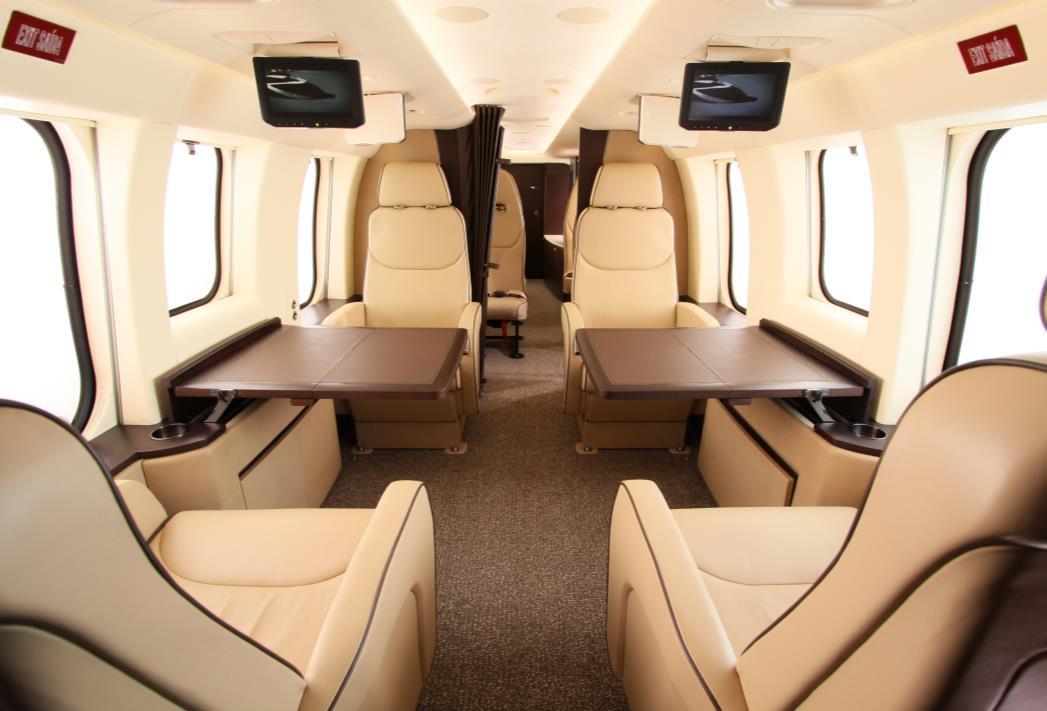
The H225 is a long-range passenger transport helicopter developed by Eurocopter, now Airbus Helicopters, as the next generation of the civilian Super Puma family. Designed primarily for the offshore oil and gas market in the 24-passenger class segment, this heavy helicopter has proved very popular on the VVIP market for government officials and heads of state transportation.

The H225 first flew on November 27, 2000, prior to entering service in July 2004. The H225 design is based on the AS332 super puma “H215”, replacing the four-blade with a five-blade main rotor with a new airfoil shape to reduce vibration and noise levels. The H225 is powered by two dualchannel FADEC-controlled Turbomeca Makila 2A1 turboshaft engines mounted over the cabin. The H225 features a modern full-glass cockpit.
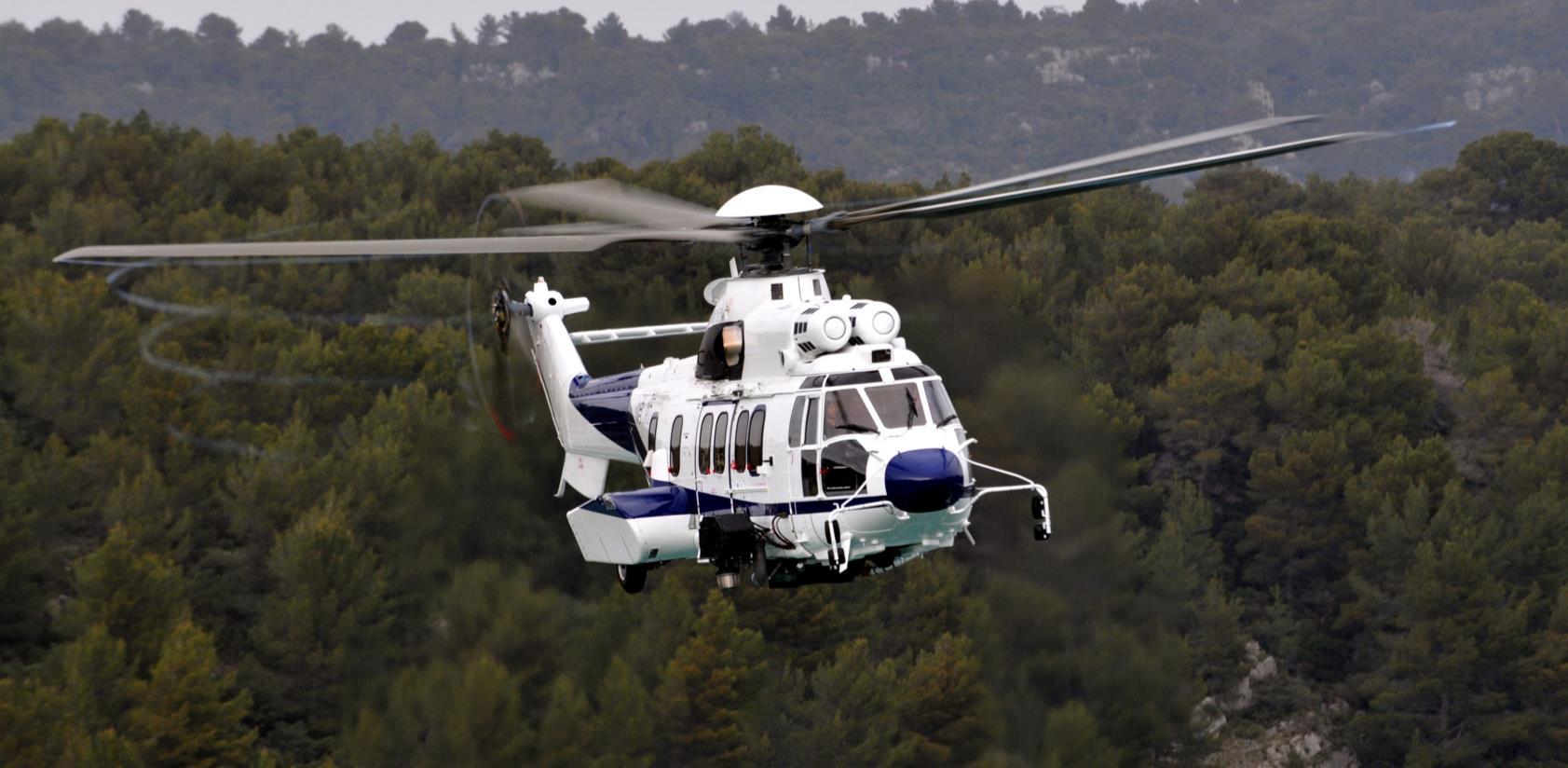
CATEGORY: HEAVY PERFORMANCE Range 452 nm Max EnduranceMax Cruise Speed 175 kts Economy Cruise Speed 150 kts Service Ceiling 13,257 ft Hover IGE Ceiling 6,350 ft Hover OGE Ceiling 2,600 ft WEIGHTS Max Takeoff 24,251 lbs Basic Operating 11,852 lbs Max Payload 12,399 lbs Usable Fuel 4,550 lbs SYSTEMS AVIONICS ManufacturerModelENGINES Number of Engines 2 Manufacturer Safran Helicopter Engines Model Makila 2A1 Takeoff Power 1,747 shp Max Continuous Power 1,747 shp CABIN Max Passengers ~ 11 Cabin Height 7 ft Cabin Width 5 ft Cabin Length 26 ft Cabin Volume 547 cu.ft Baggage CompartmentELITE WINGS MAGAZINE |
SIKORSKY | S-92
The S-92 is a multi-purpose heavy helicopter developed by US helicopter leader Sikorsky for long-range offshore oil and gas operations support.
Launched in 1992, the S-92 completed its first flight on December 23rd , 1998, before its FAA certification in December 2002.
The S-92 is powered by twin General Electric CT7-8A turboshaft engines driving a four-bladed fully articulated rotor. The airframe is made from aluminum with few composite components and features an advanced active vibration control system and an Auxiliary Power Unit (APU) providing DC Power and Hydraulic pressure for ground operation.
The S-92 has been selected by the United States Marine Corps to replace the older Sikorsky SH-3 Sea-King as the new Marine One U.S. presidential transport helicopter, under the VH-92 designation.

CATEGORY: HEAVY
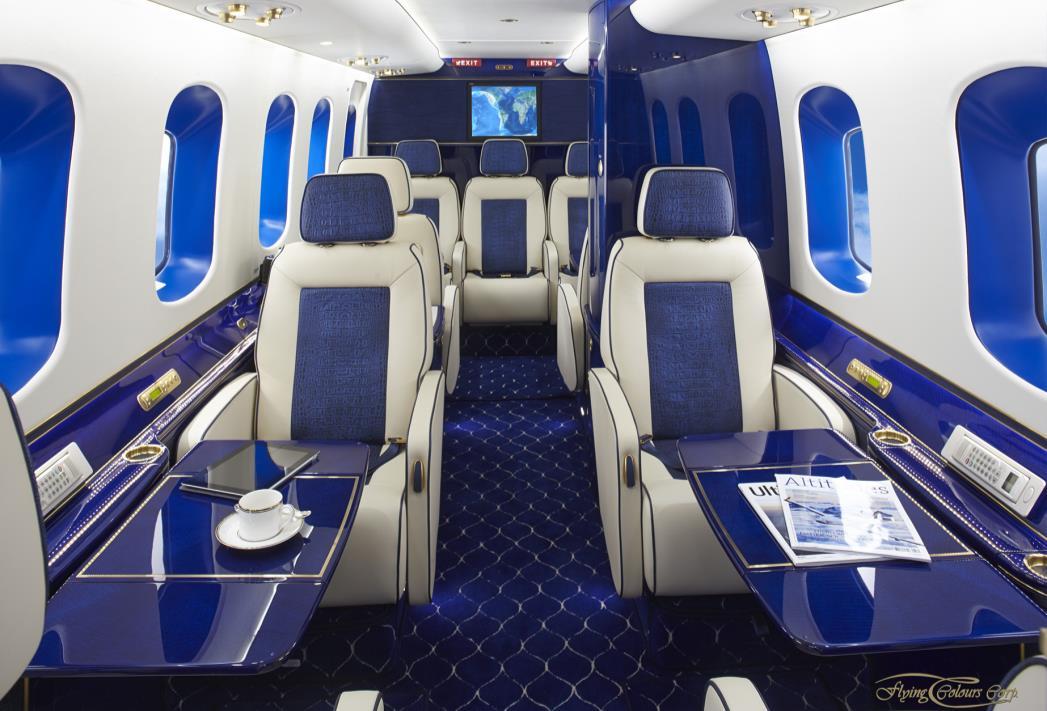
PERFORMANCE Range 546 nm Max EnduranceMax Cruise Speed 151 kts Economy Cruise Speed 136 kts Service Ceiling 15,000 ft Hover IGE Ceiling 9,200 ft Hover OGE Ceiling 6,700 ft WEIGHTS Max Takeoff 26,500 lbs Basic Operating 15,600 lbs Max Payload 10,900 lbs Usable Fuel 5,130 lbs SYSTEMS AVIONICS ManufacturerModelENGINES Number of Engines 2 Manufacturer General Electric Model CT7-8A Takeoff Power 2,520 shp Max Continuous Power 2,043 shp CABIN Max Passengers ~ 10 Cabin Height 7 ft Cabin Width 6 ft Cabin Length 20 ft Cabin Volume 700 cu.ft Baggage Compartment 140 cu.ft
| ELITE WINGS MAGAZINE
LEONARDO|AW101

The AW101 is a Heavy three-engine helicopter developed by Leonardo. The program was launched in 1984 as a Joint venture between Italian Agusta and UK Westland companies prior to their merger. The AW101 has been primarily designed for anti-submarine warfare and overwater Search And Rescue (SAR) missions for use by both the UK and Italian Navies as a replacement for the 1960s-era Sikorsky sea-king. The AW101 first took to the sky on October 9, 1987, prior to entering service on June 2, 2000, with the UK Royal Navy under the Merlin HM1 designation. This heavy-lift helicopter is powered by a selection of three General Electric CT7-8E or Rolls-Royce / Turbomeca RTM322 turboshaft engines, driving a five-blade rotor. The AW101 flight deck features a full glass cockpit. The AW101 can also be outfitted with a probe for aerial refueling.

PERFORMANCE Range 810 nm Max Endurance 6hr 50 min Max Cruise Speed 150 kts Economy Cruise SpeedService Ceiling 15,000 ft Hover IGE Ceiling 10,850 ft Hover OGE CeilingWEIGHTS Max Takeoff 34,390 lbs Basic Operating 20,188 lbs Max Payload 12,000 lbs Usable Fuel 9,058 lbs SYSTEMS AVIONICS Manufacturer Leonardo Helicopters ModelENGINES Number of Engines 3 Manufacturer General Electric Model CT7-8E Takeoff Power 2,527 shp Max Continuous Power 2,041 shp CABIN Max Passengers 8-14 Depending on configuration Cabin Height 8 ft Cabin Width 6 ft Cabin Length 21 ft Cabin Volume 973 cu.ft Baggage Compartment 135 cu.ft CATEGORY: HEAVY ELITE WINGS MAGAZINE |

© 2023 ELITE WINGS MEDIA ELITE WINGS MAGAZINE Issue 04 | 2023 WWW.ELITE-WINGS.COM WWW.ELITE-WINGS.COM


















 By Abdelmajid Jlioui
By Abdelmajid Jlioui

















 By Abdelmajid Jlioui
By Abdelmajid Jlioui

















 By Abdelmajid Jlioui
By Abdelmajid Jlioui




 By Abdelmajid Jlioui
By Abdelmajid Jlioui



















































